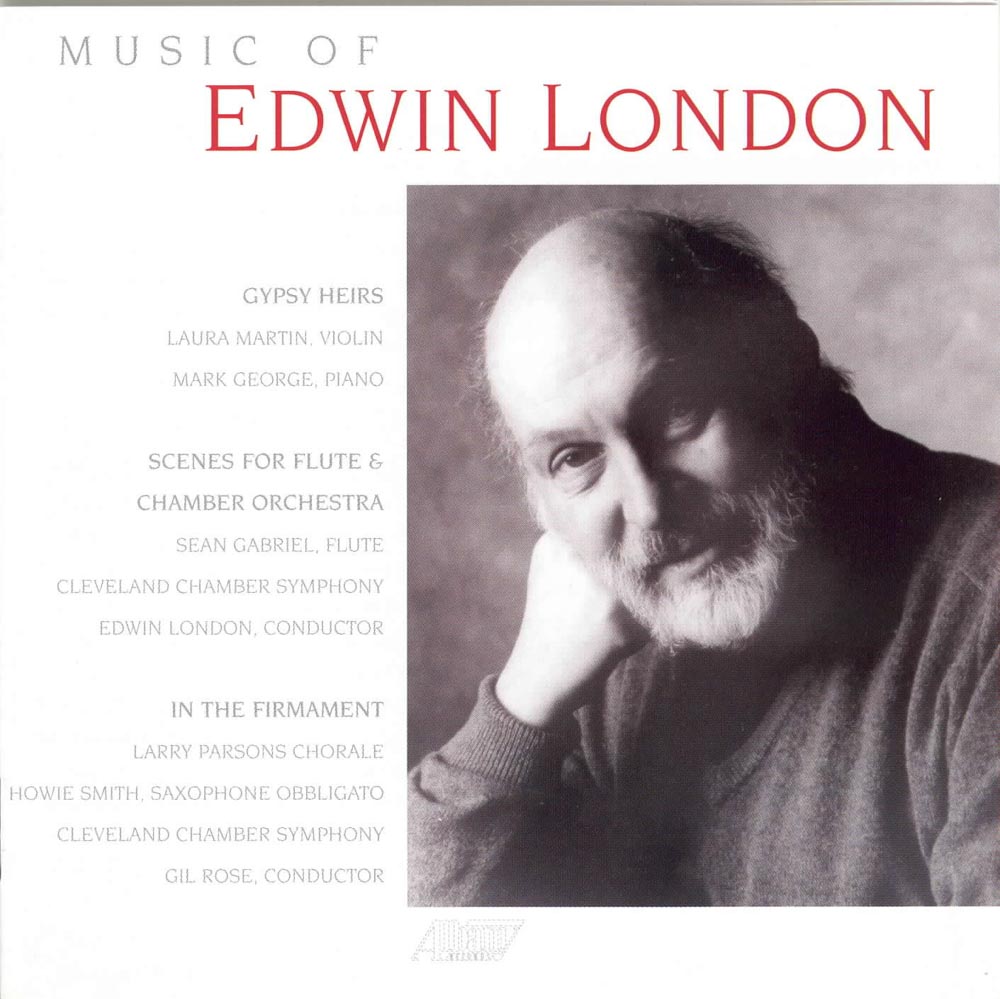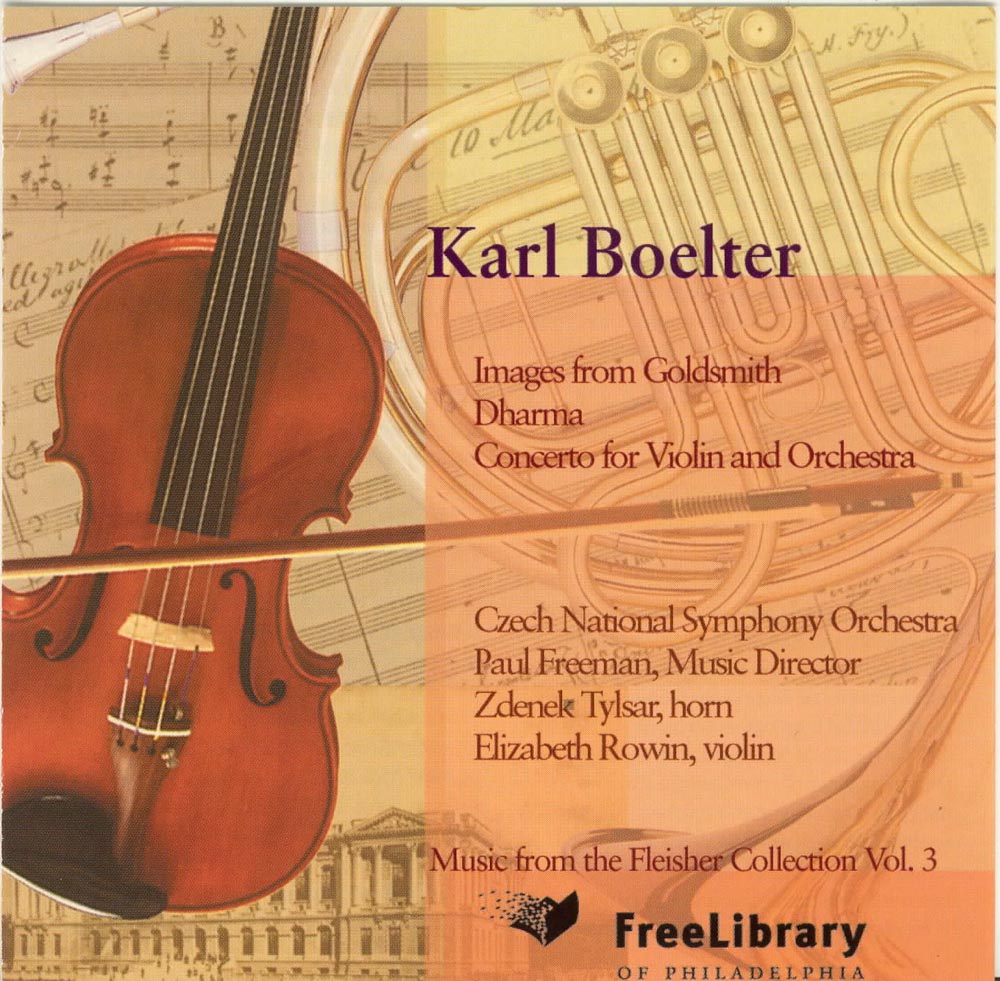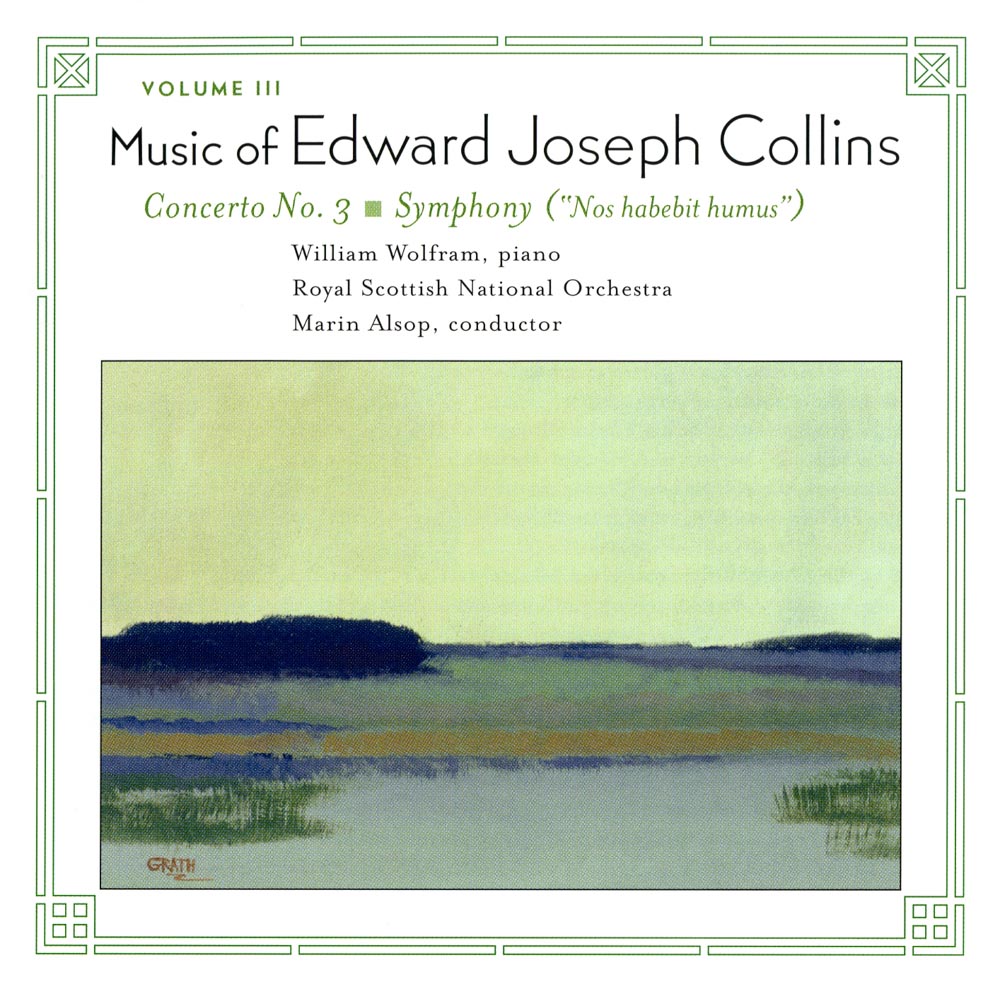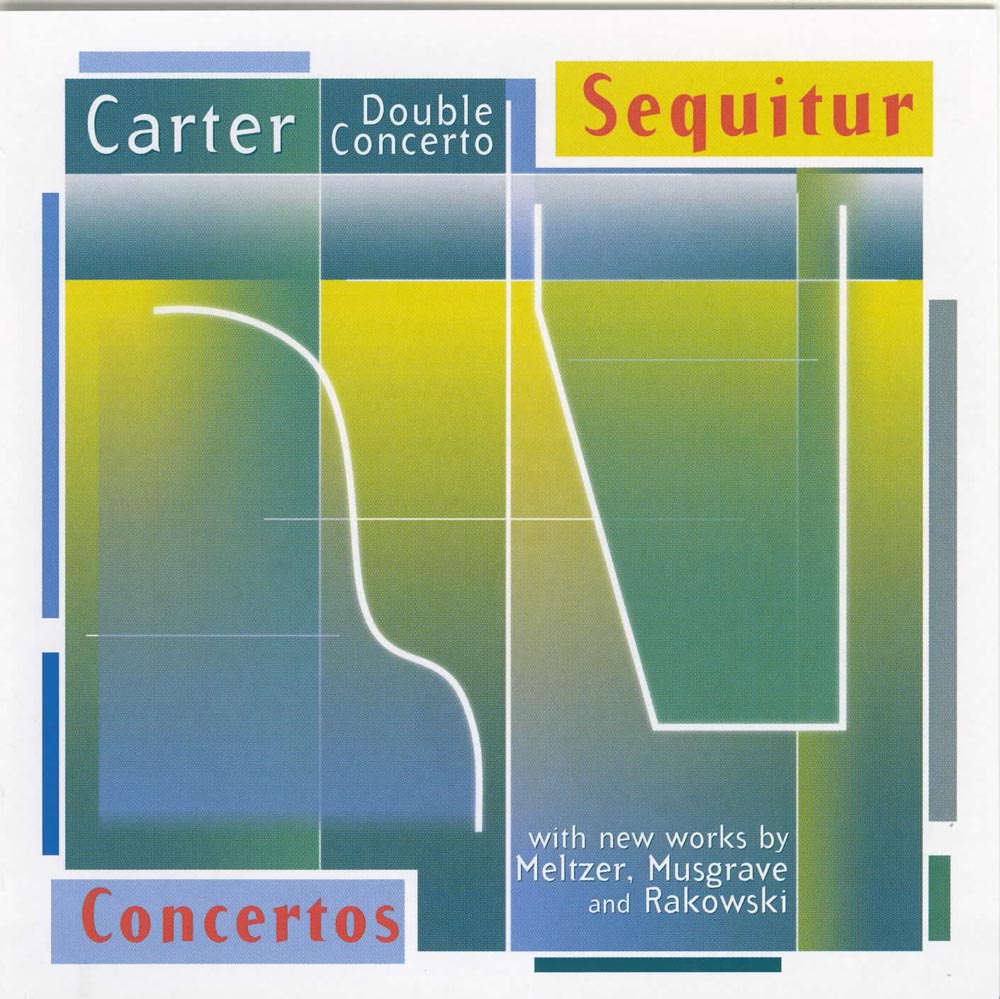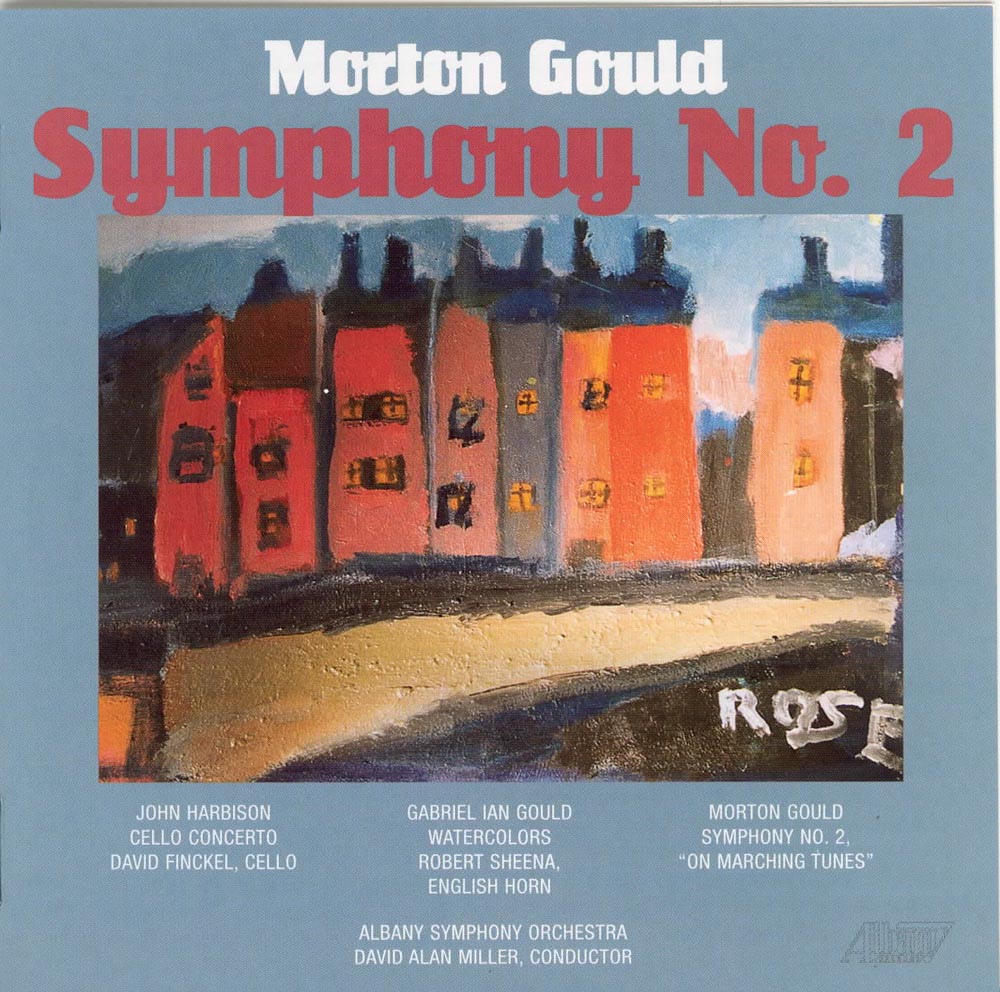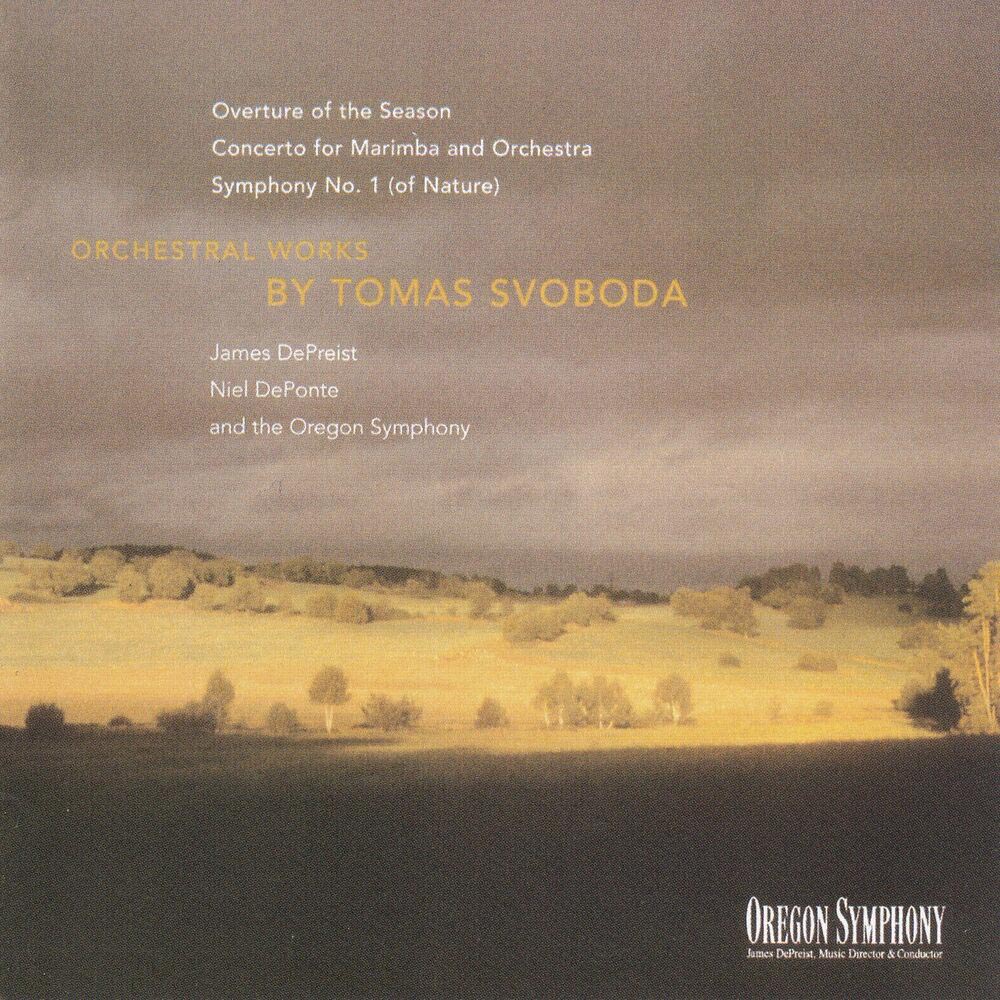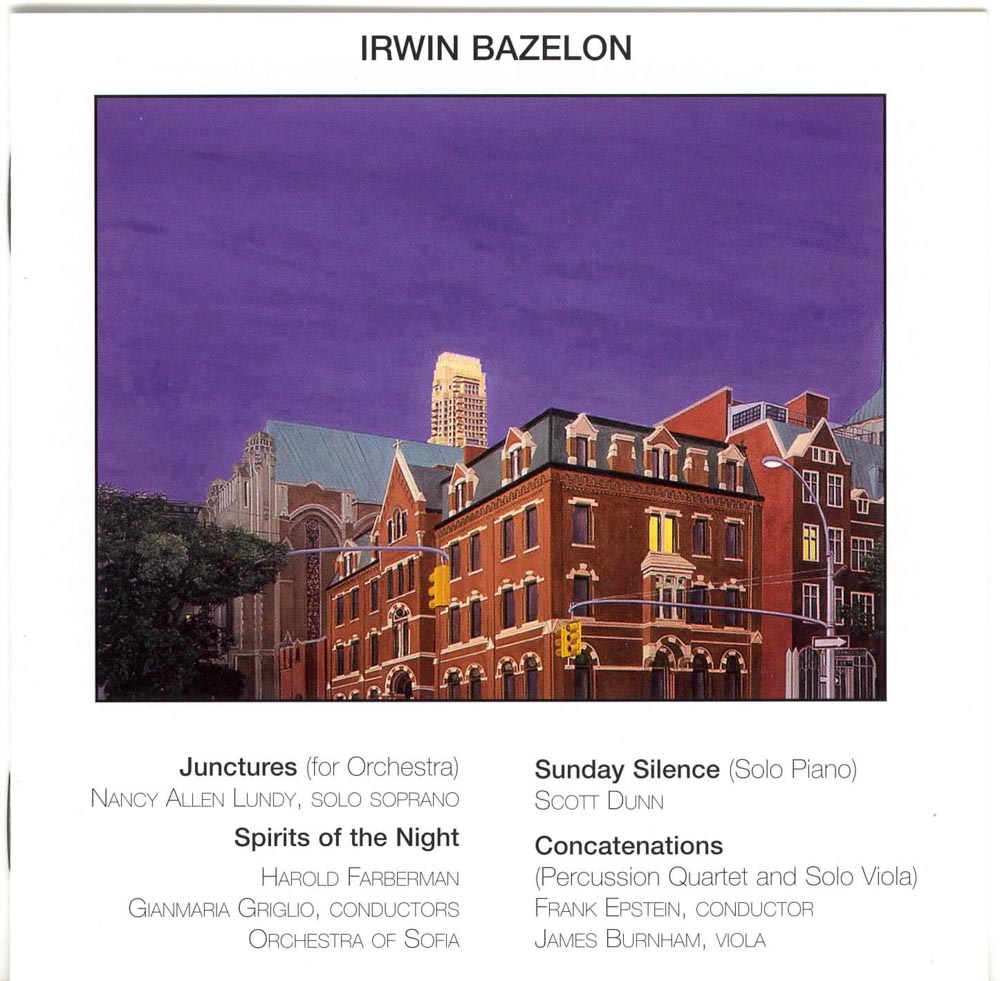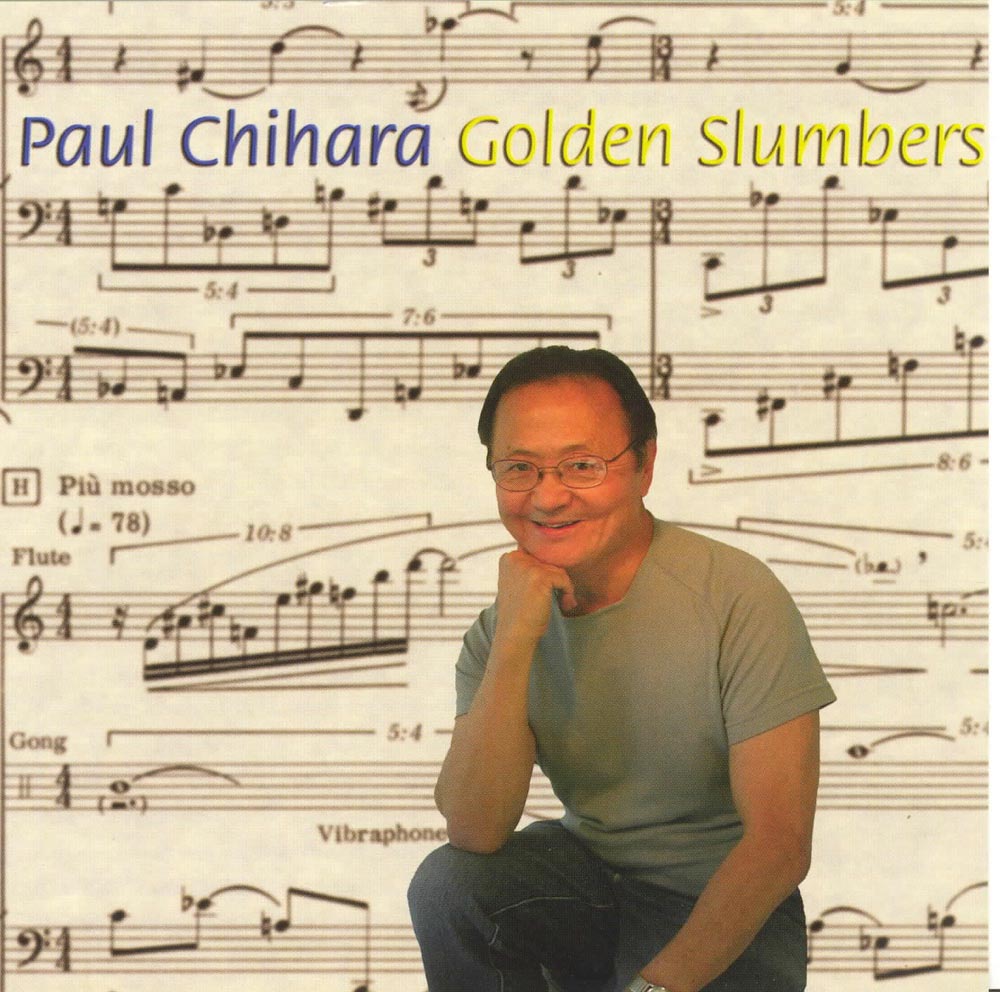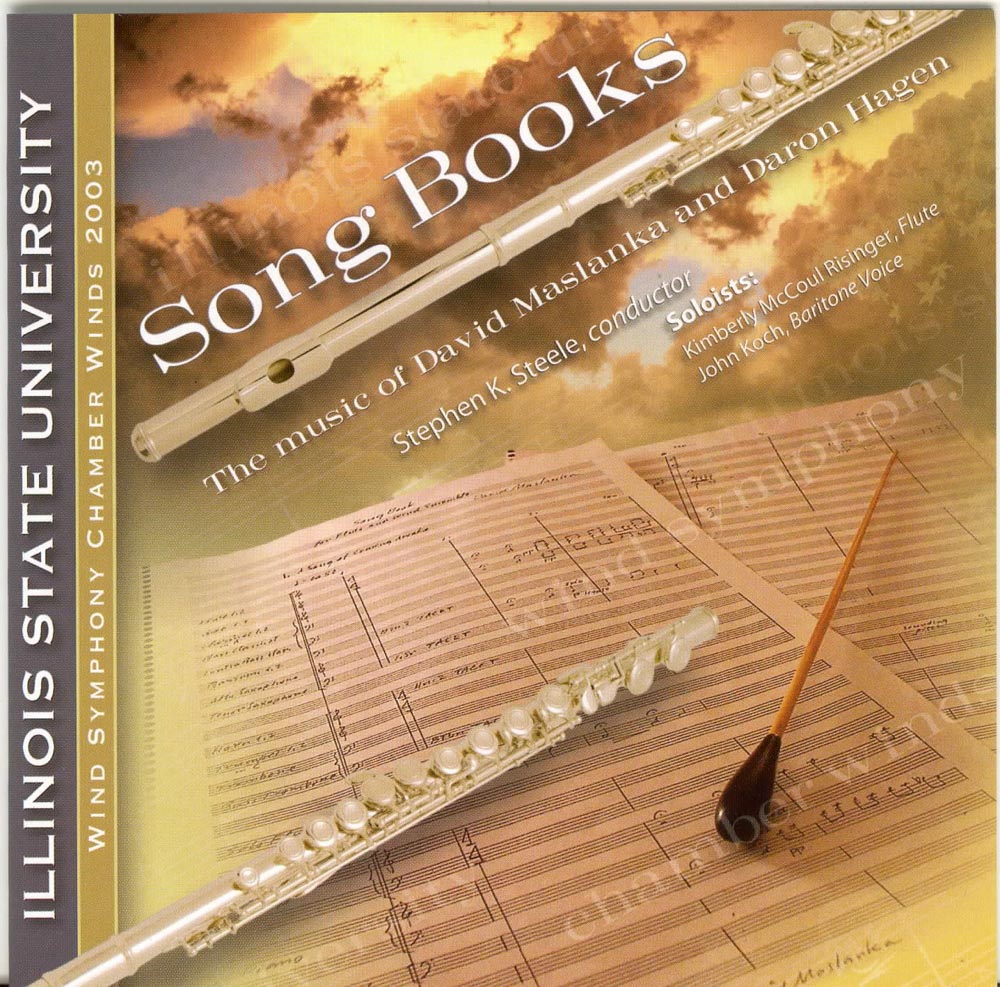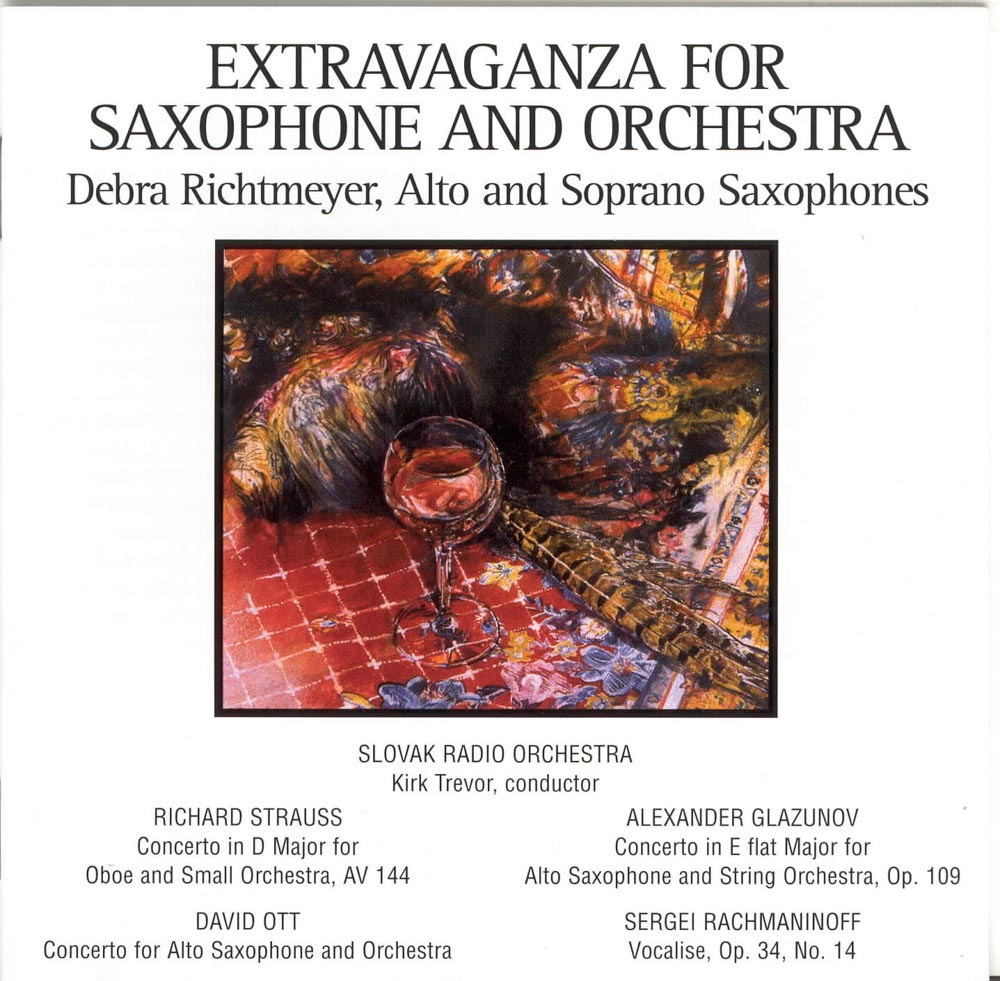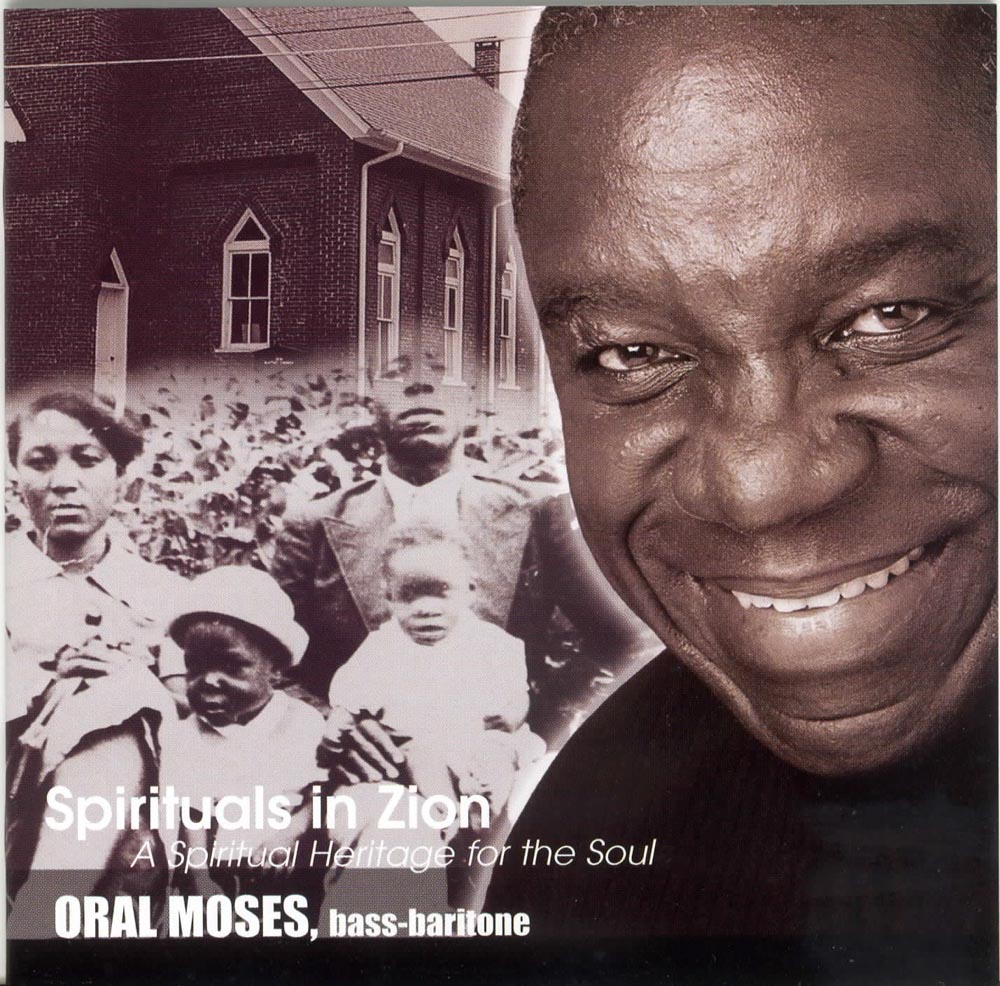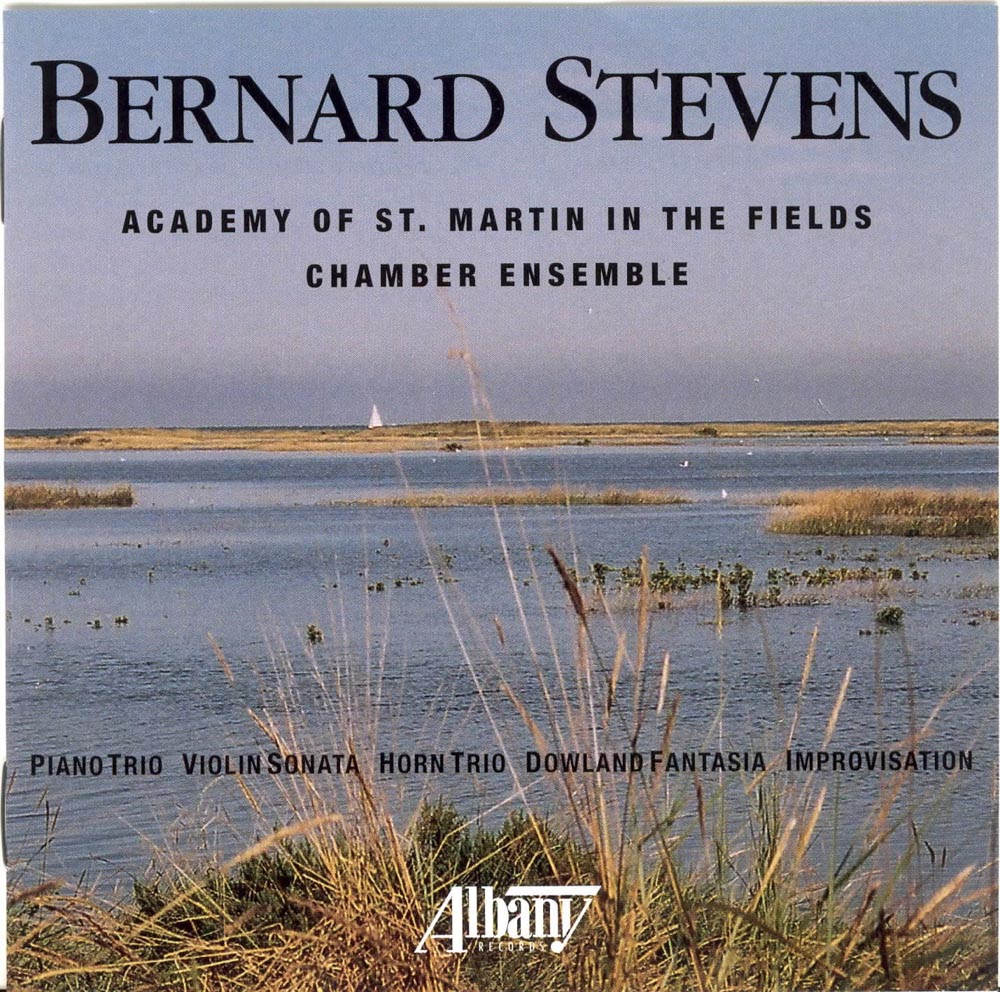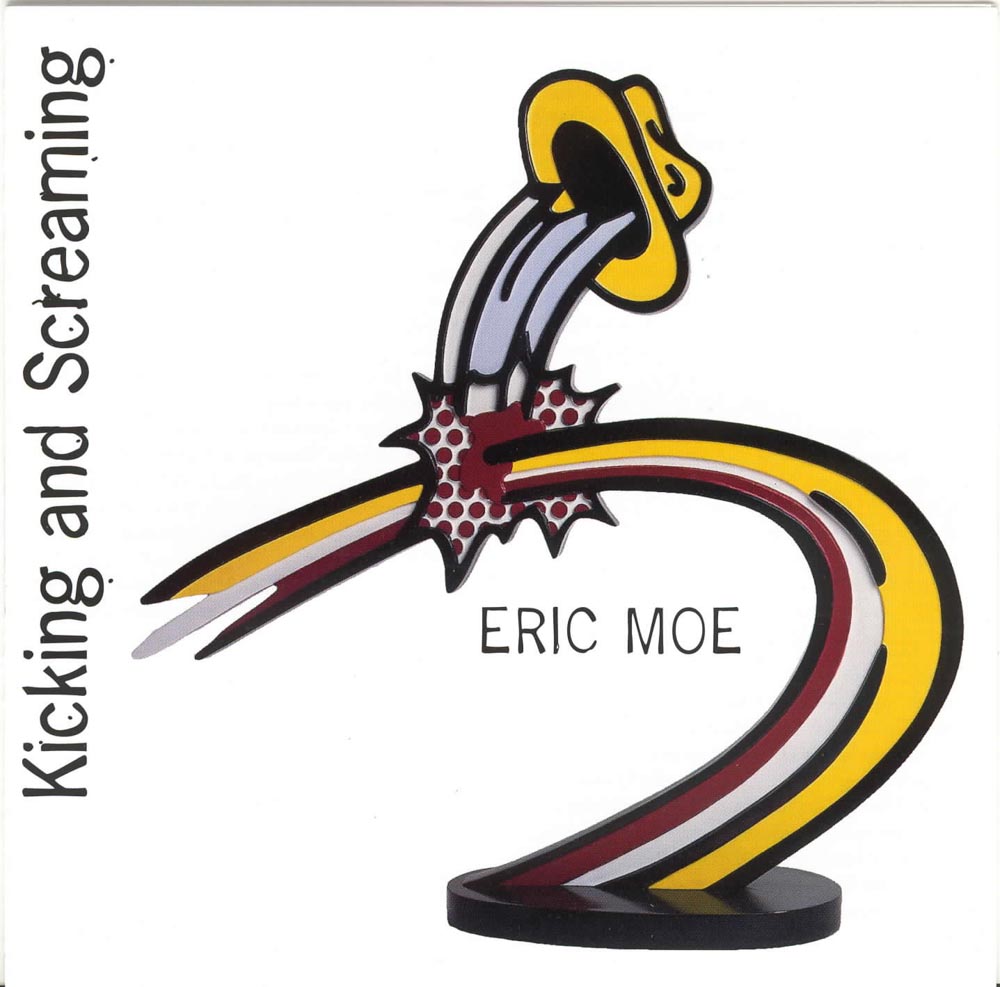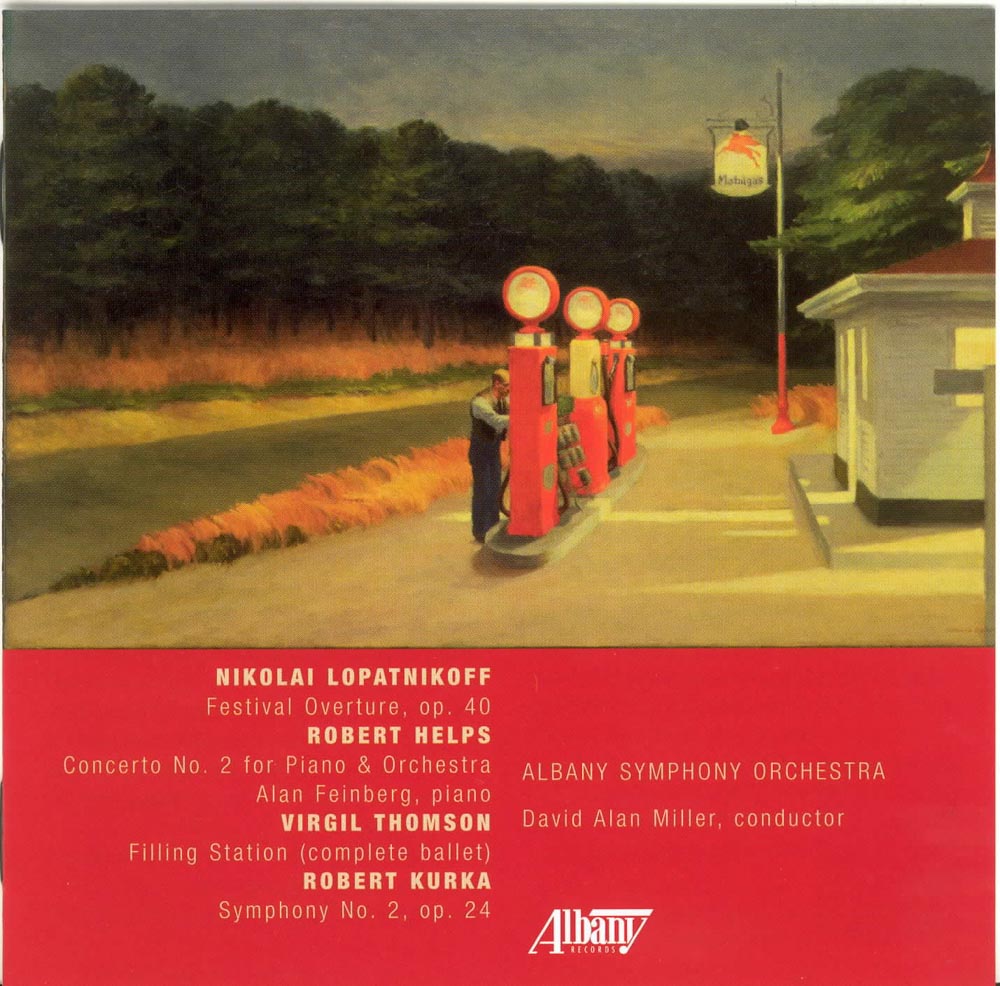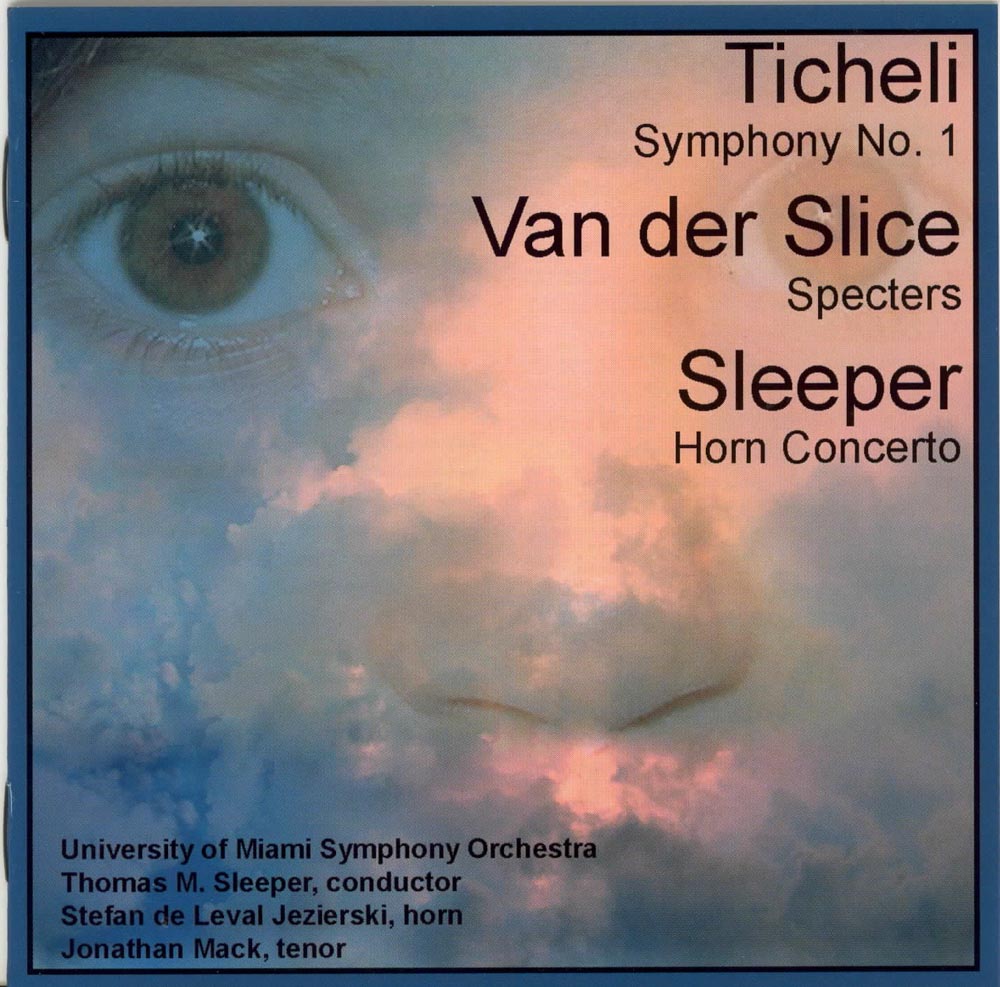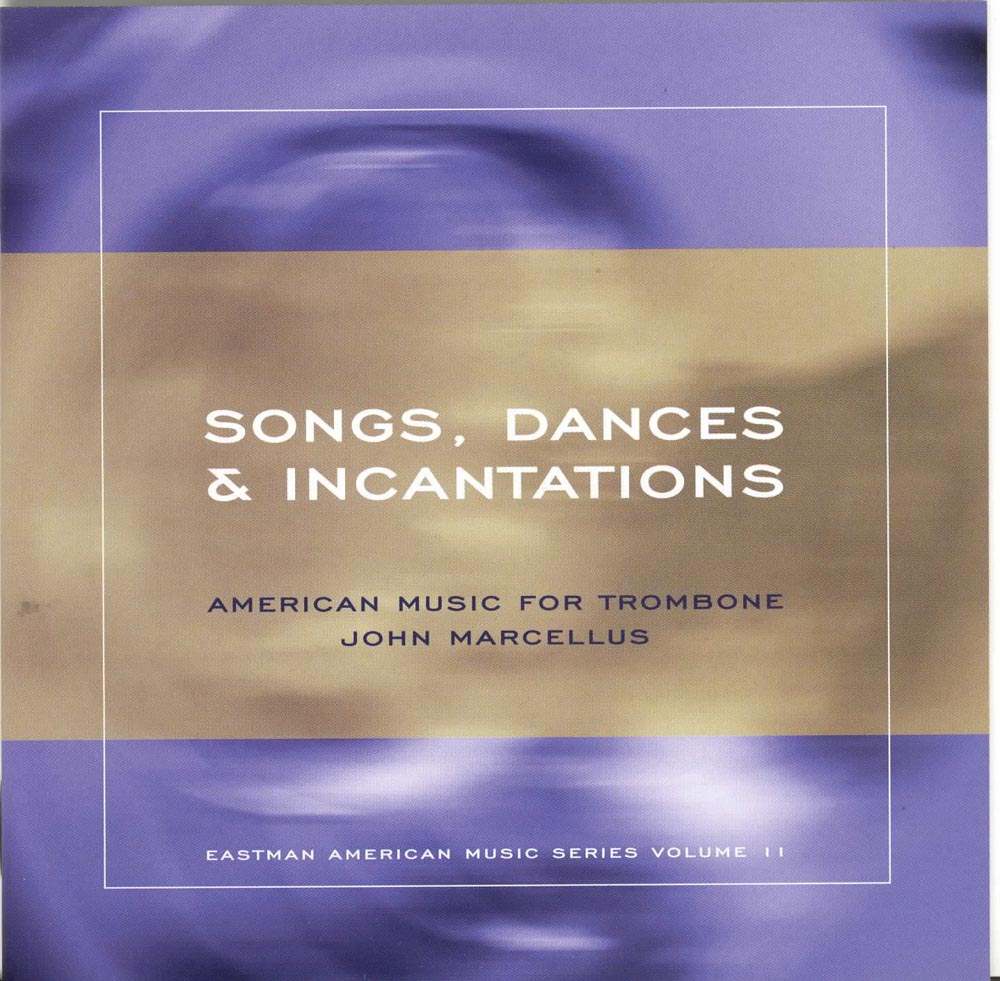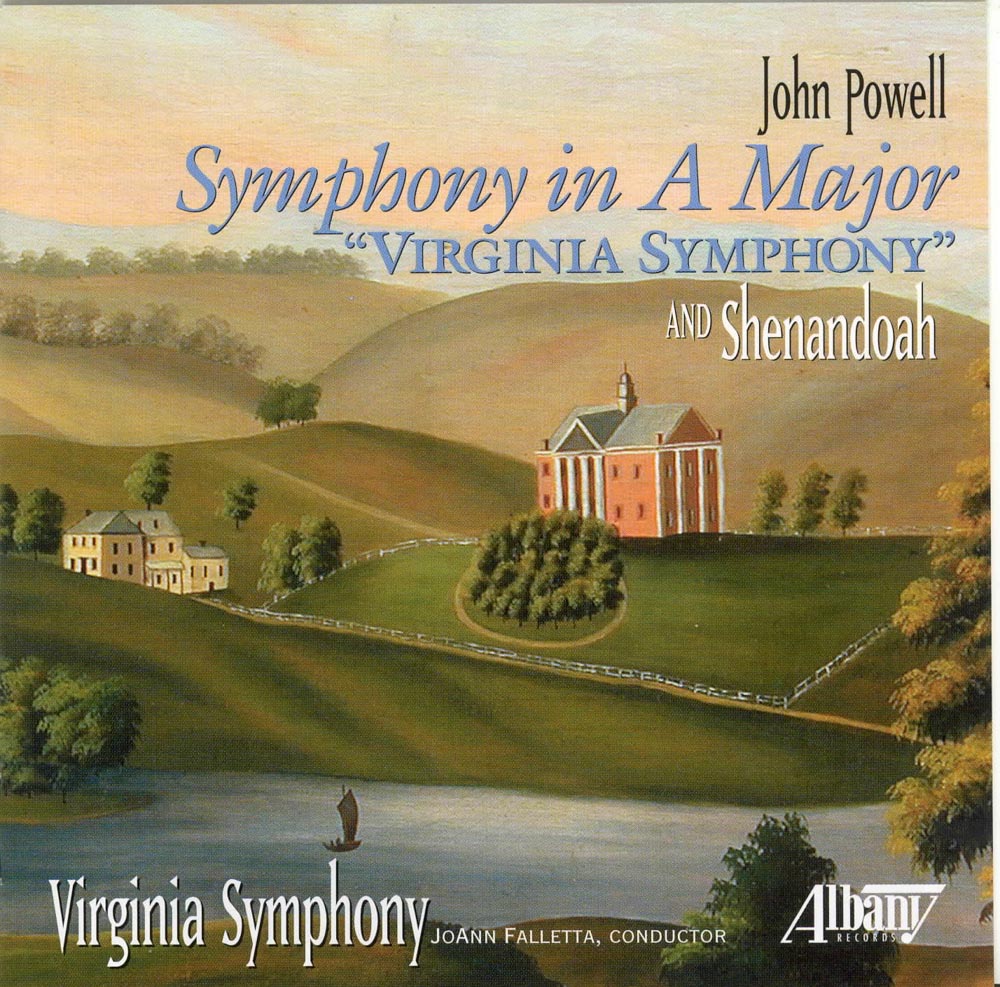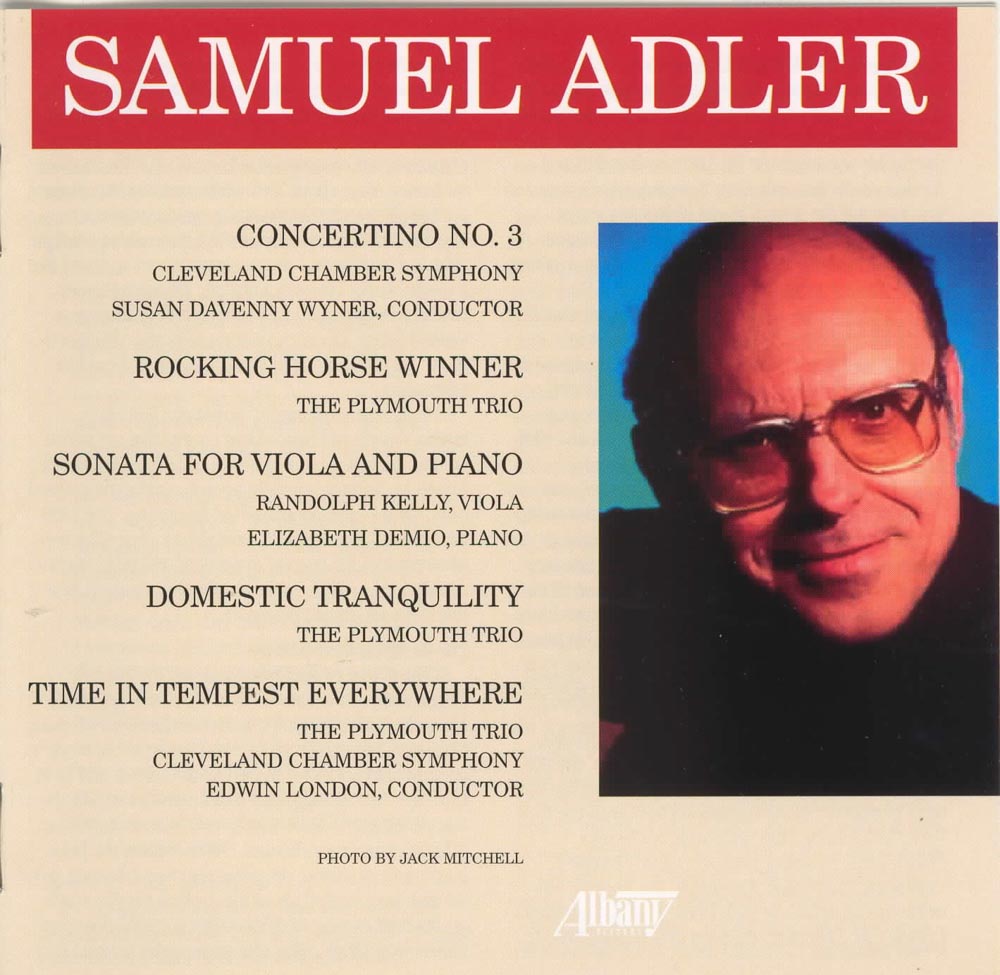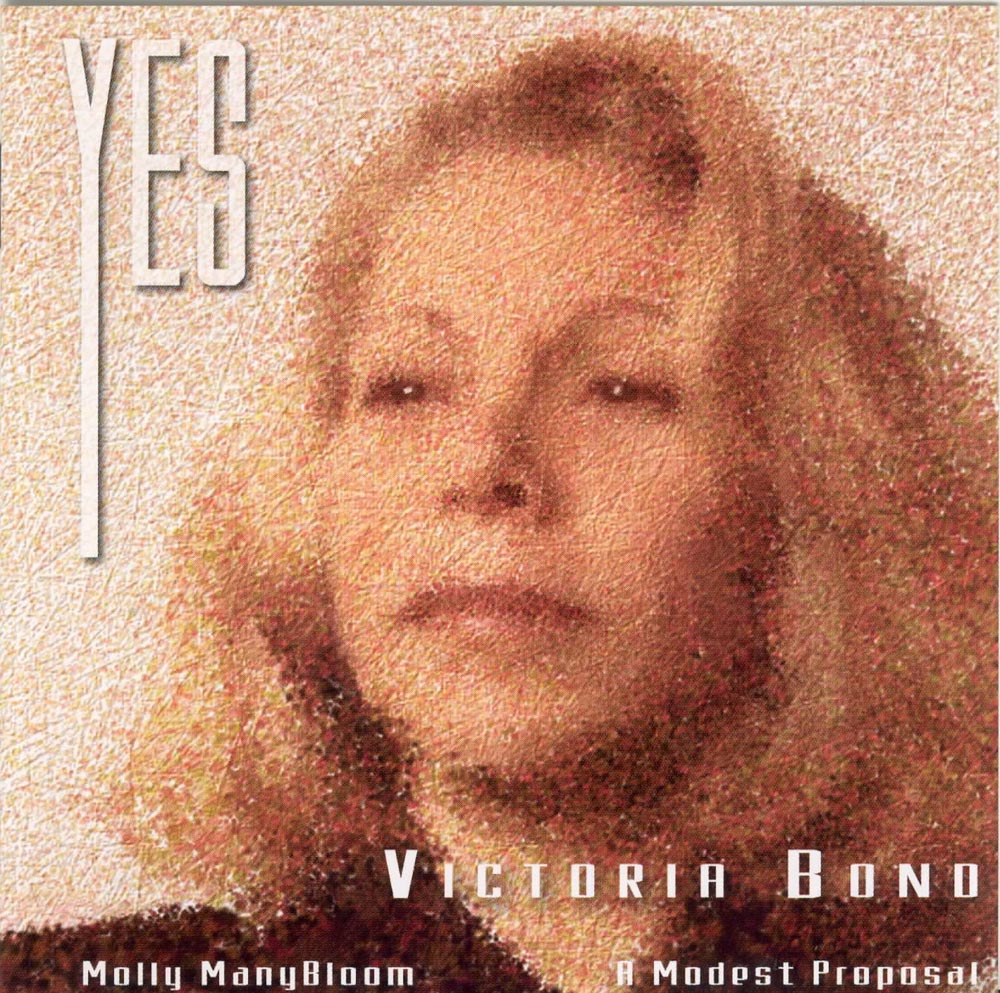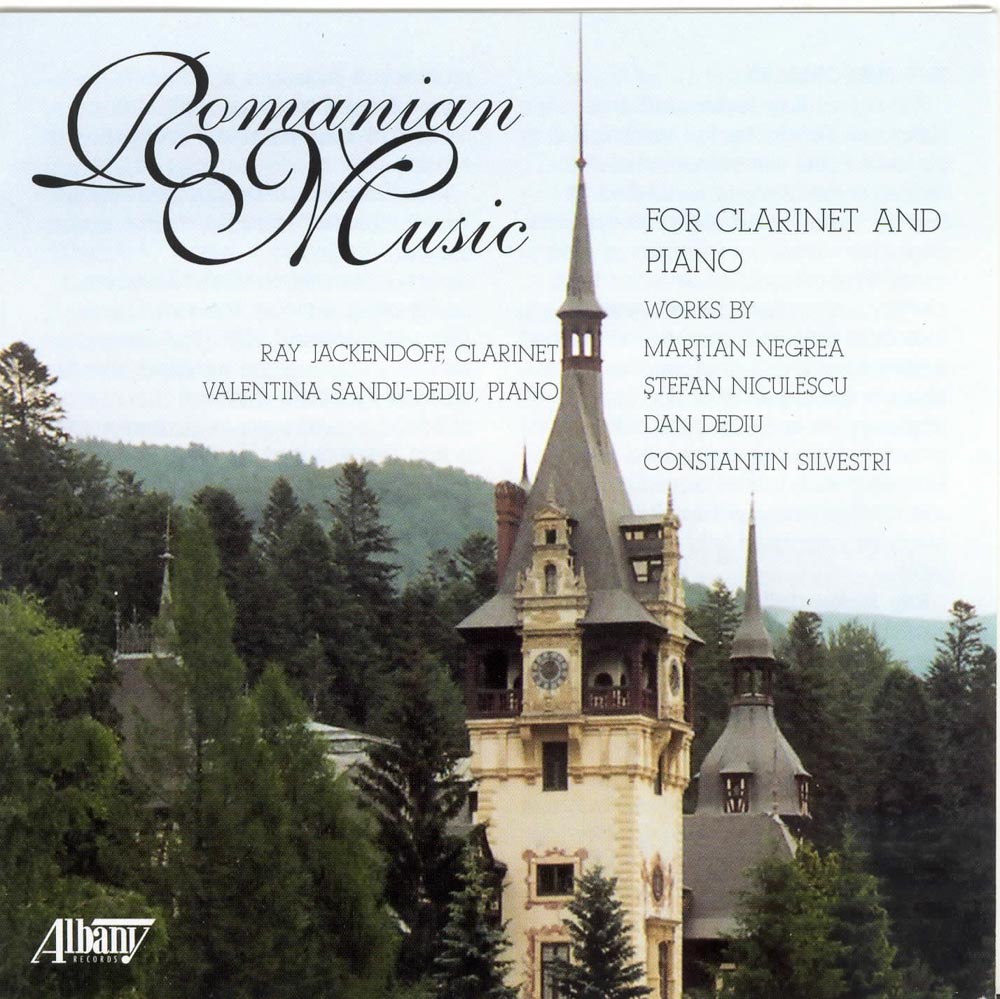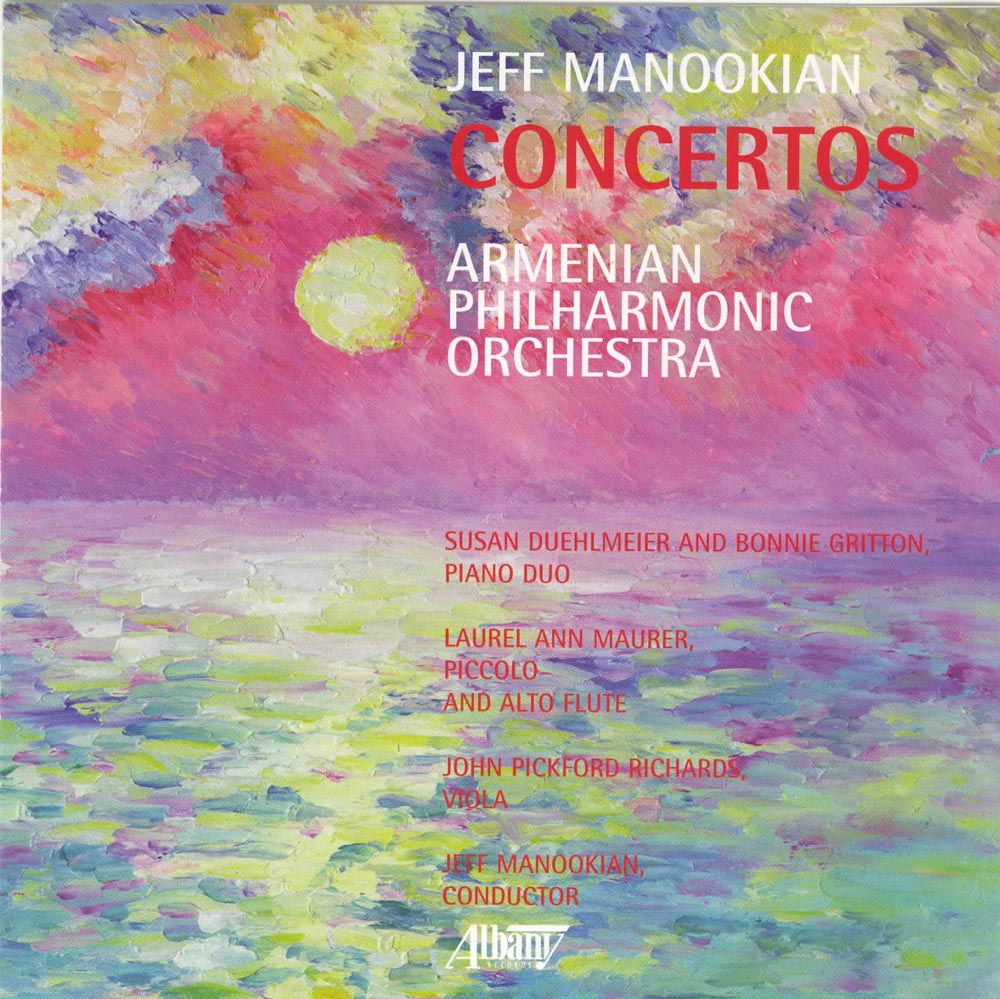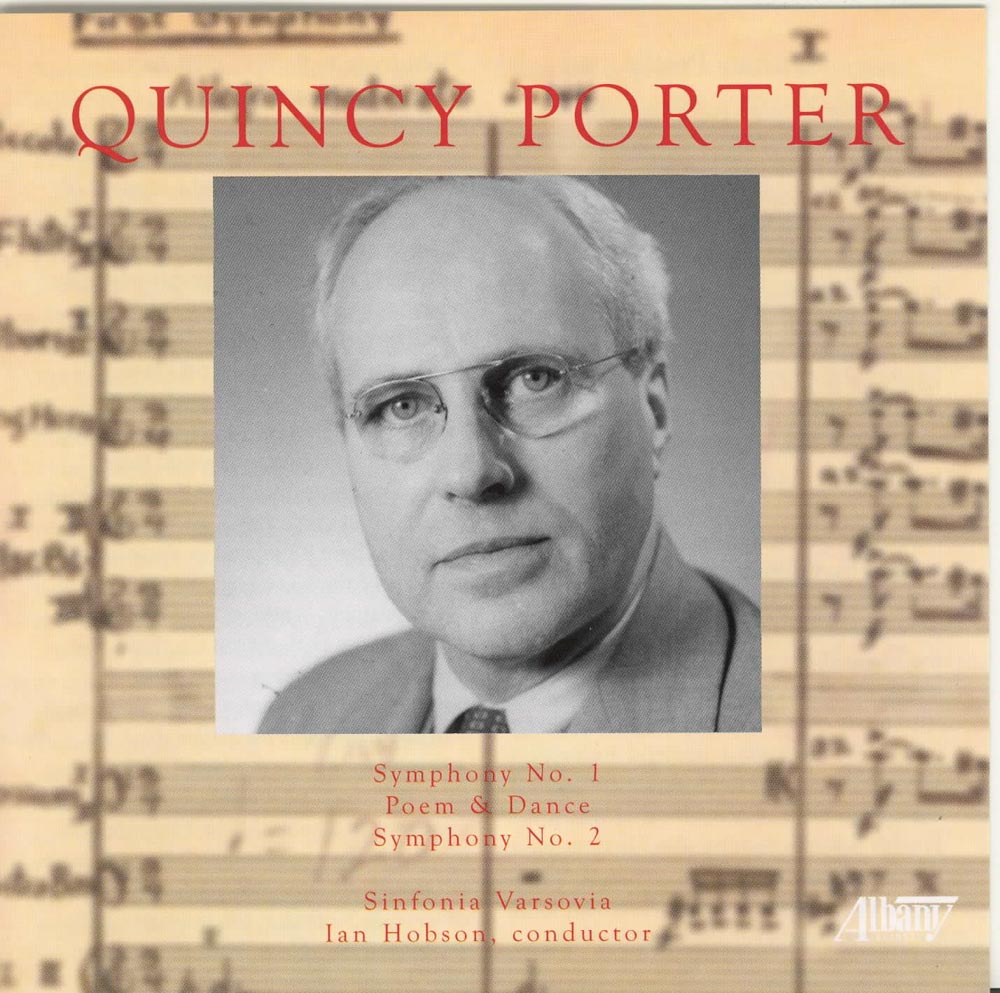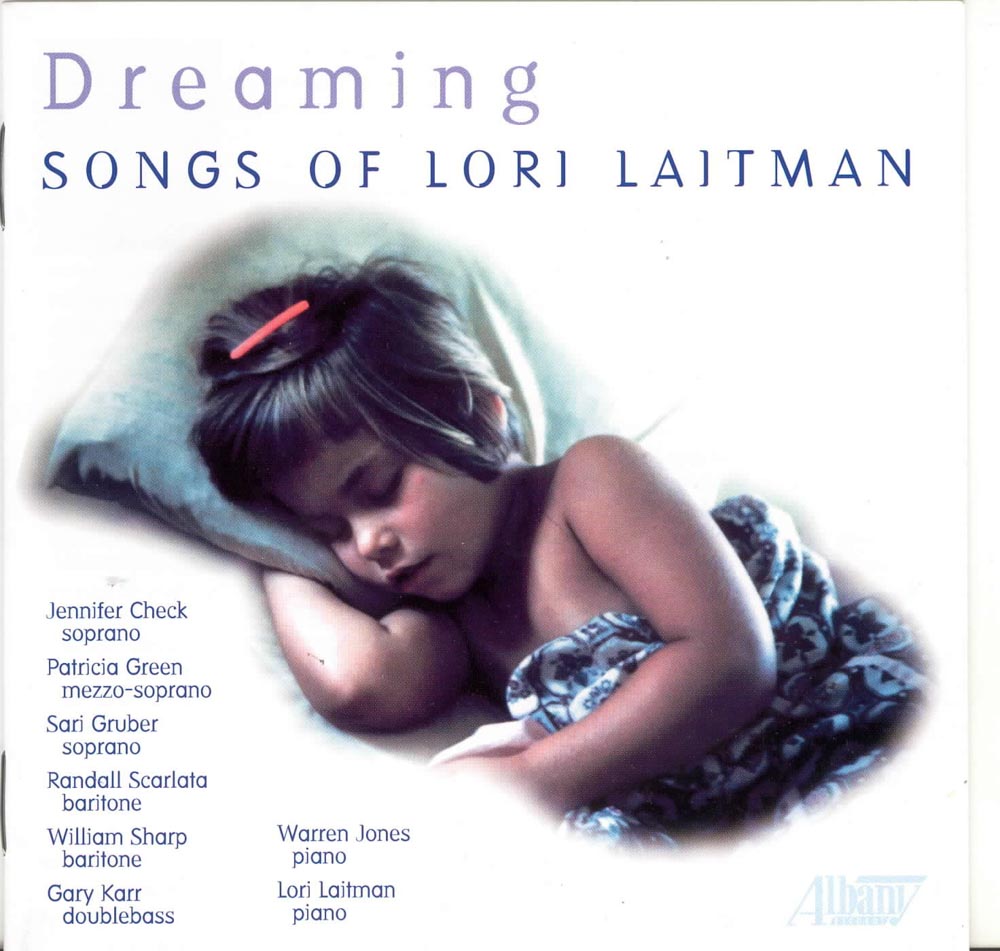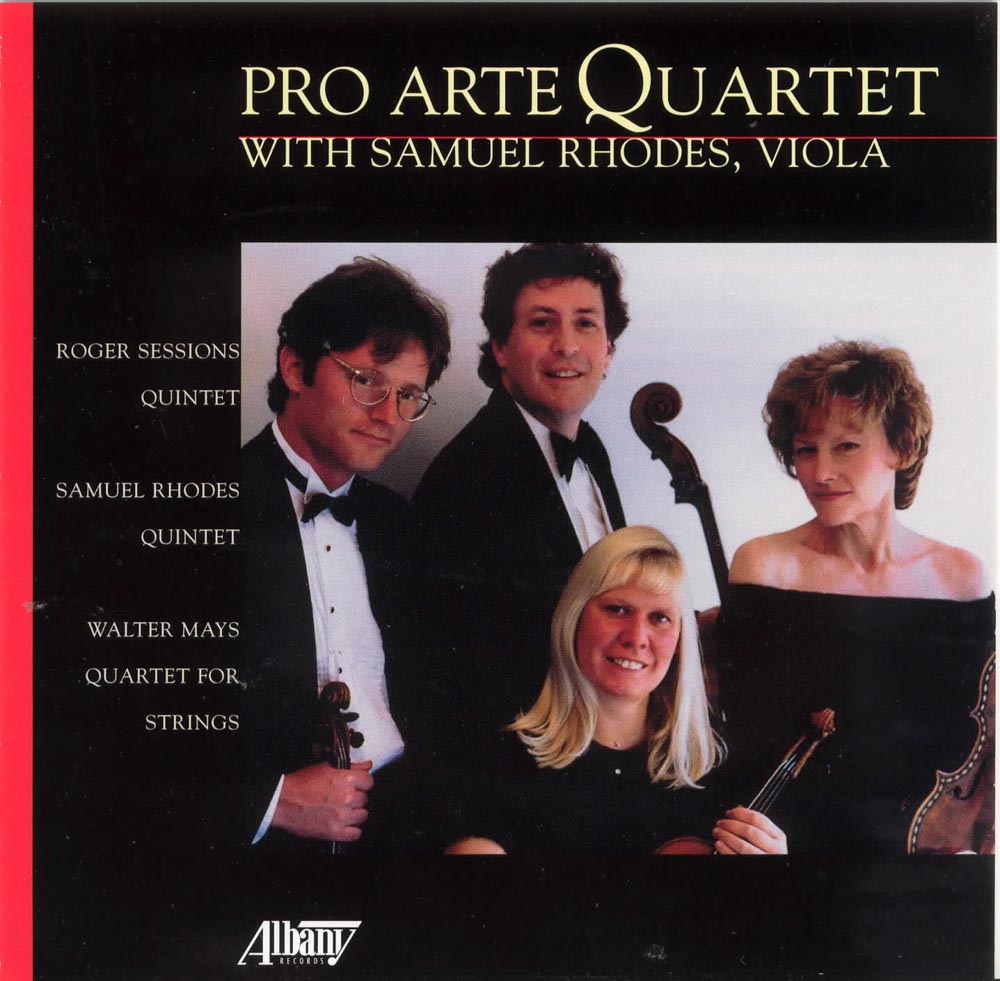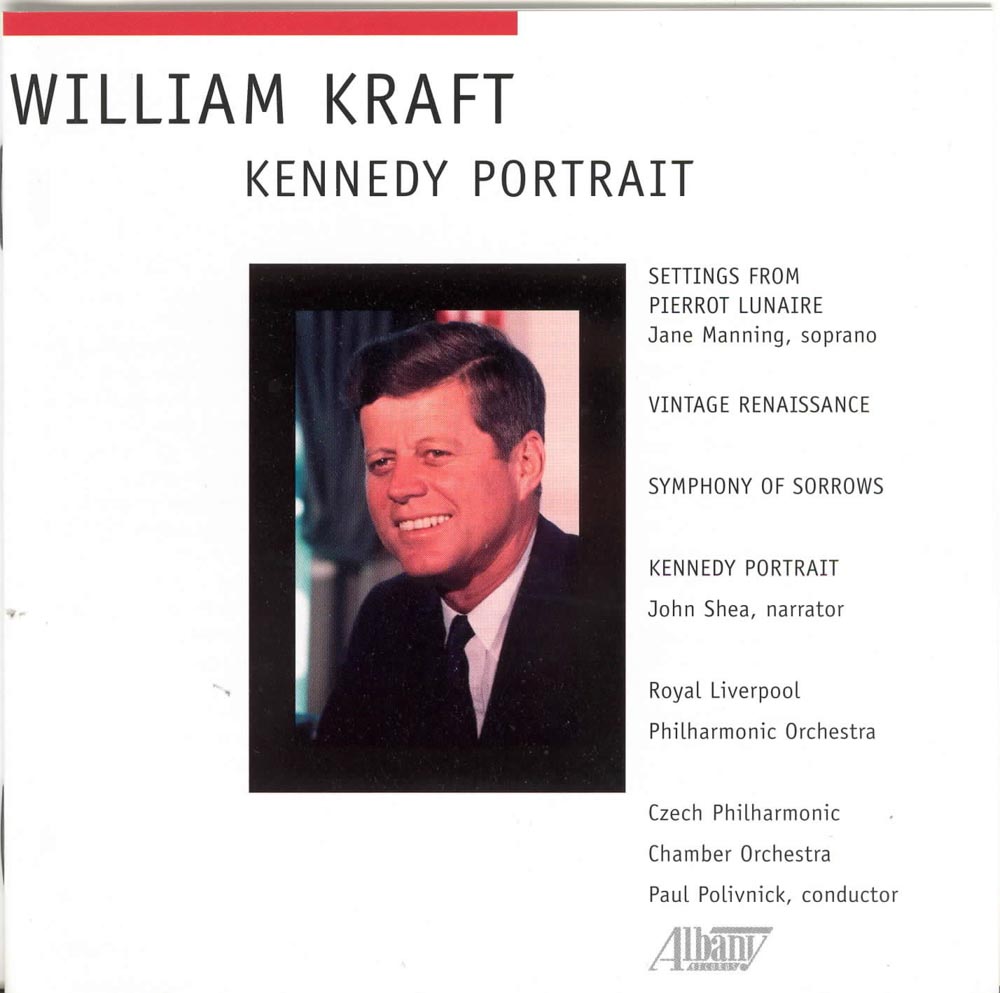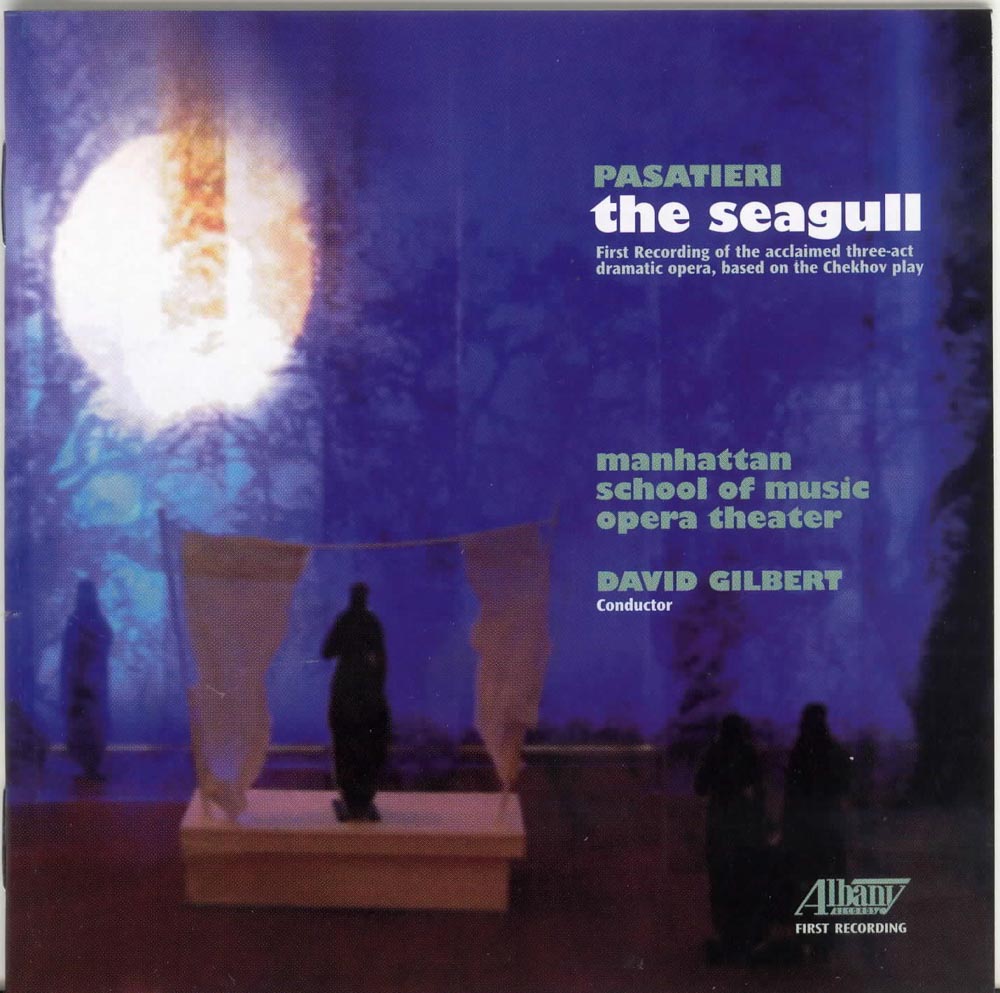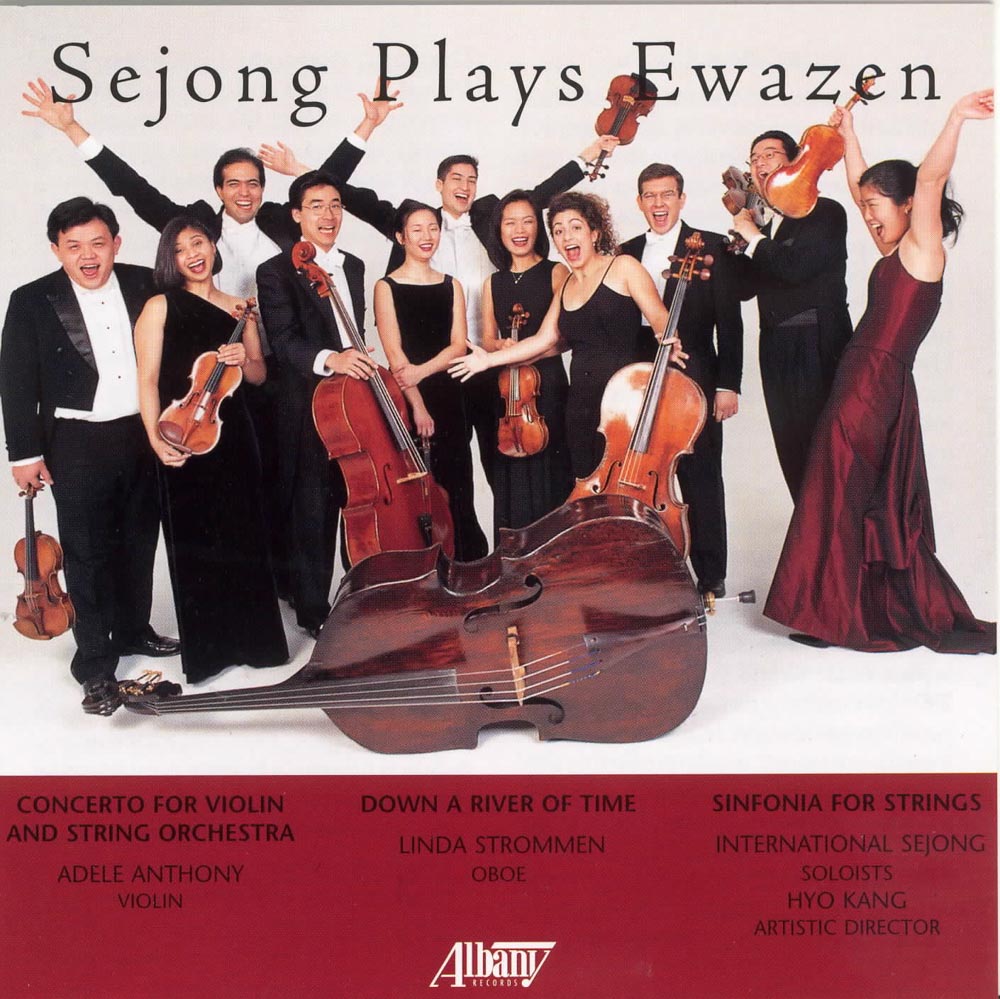Catalog #: TROY0595
Release Date: October 1, 2003ChamberEdwin London's music, sometimes literary or sacred, often theatrical, and at times humorous, is the product of his broad experience in diverse styles. London has been a major figure in the field of new music for more than 40 years. Best described as "a champion of new American music" he has formed two highly acclaimed ensembles: Ineluctable Modality, a new music choral ensemble in 1968, and the Cleveland Chamber Symphony in 1980. As a composer, conductor, teacher, administrator and persuasive advocate for the value of music as a civilizing force, his influence has been extraordinary. Born in Philadelphia, he began his career with characteristic disregard of rigid musical categories, as a horn player in both symphony orchestras and the Oscar Pettiford jazz band. Everything London has done in his long career has reflected his ability to move easily between the worlds of "concert hall" and "popular" music - with occasional stops at places in between.
Catalog #: TROY0594
Release Date: October 1, 2003OrchestralKarl Boelter's music ranges from contemplative to visceral, from serious to playful. He was born in Milwaukee and studied composition at Ball State and the University of Michigan. He has studied with William Bolcom, Leslie Bassett and William Albright. For several years, he resided in Atlanta where he served as music curator at the High Museum of Art. This experience provided direct involvement with performances by some of the 20th century's greatest artists as well as a personal exploration into the diversity of artistic expression: classic blues and jazz, Cajun two-steps, the music of Africa, and Cowboy poetry. Dr. Boelter is professor of music composition at Oakland University, Rochester, Michigan, where he currently serves as Chair of the Department of Music, Theater and Dance.
Catalog #: TROY0625
Release Date: September 1, 2003OrchestralEdward Joseph Collins was born in Joliet, Illinois and was the youngest of nine children all of whom were musical. He studied first in Chicago with Rudolf Ganz and then in Berlin with Max Bruch and Engelbert Humperdinck, among others. He returned to the United States in the fall of 1912 and began to concertize. During 1913/14, he was appointed assistant conductor of the Century Opera Company in New York. In 1914, he traveled once again to Europe where he was engaged as an assistant conductor at the Bayreuth Festival, where his duties also included playing the timpani. In August 1914, the outbreak of hostilities in Europe necessitated his return to America. When the U.S. entered the War, he began as an infantry private, but soon rose to the rank of Lieutenant. When Collins returned to Chicago, he resumed his performing career and married a young voice student named Frieda Mayer whose father was Oscar Mayer, the owner of the Chicago Meat Packing Company that bears his name. Erik Eriksson, Collins' biographer has written: "The music of Edward Joseph Collins deserves closer attention and more frequent performance. Collins was highly original in his organization and employment of ideas, in the flow with which they were assembled, and in the unforced introduction of American idioms to works that were conceived with great seriousness of purpose. With strength of character and courage that must be admired, Collins composed music that also exhibits an endearing capacity to convey genuine and enduring emotion." See also TROY267 for more of Collin's music.
Catalog #: TROY0607
Release Date: September 1, 2003ChamberFor seven years, the New York-based contemporary music ensemble Sequitur has been re-defining the concert by finding new contexts for new music. Through staging events incorporating theater and dance, or producing tantalizing cabarets on themes like lust and greed, Sequitur turns the traditional sanctimonious contemporary music experience upside down. On this disc, they re-examine the contemporary American concerto. Although it dates back to Baroque composers in the late 17th century, the concerto reached its artistic pinnacle with Romantic composers of the 19th and early 20th century. But what does the concerto mean in the United States at the beginning of the 21st century, when personal freedoms are threatened both by indiscriminate acts of terrorism and by responses that many find necessary in order to preserve safety and stability? For starters, the paradigm of “us versus them” – the message behind the concertino and ripieno of the Baroque concerto grosso as well as the heroic romantic solo concerto – seems outmoded. We shun the model of a group controlling an individual, just as we shun this model turned inside out. And our view of an individual now is rarely one of hero, or anti-hero, or even of complete self-determination. All of these ideas affect the concerto of today, where the role of the soloist is not always clearly defined, where other players may rise as soloists at times and then disappear again into the fabric, where sub-groups may compete with the soloist and with each other for prominence, where the soloist may not be poised to interact and hopefully to triumph. Even the word “concerto” may be suspect: Only Elliott Carter’s work among the four on this disc employs the word “concerto” in its title.
Catalog #: TROY0606
Release Date: September 1, 2003VocalThe works on this CD present a collection of songs that reflect the richness and sophistication of the American song tradition from the 19th century up through the end of the 20th century. The first half of this recording includes Battle Pieces, a song cycle written by Warren Michel Swenson; the second half contains 11 19th century songs by European and African American composers. All the works on this CD interact with two central themes: the Civil War era and the interconnections between the Black and White culture in America. In his song cycle, Swenson, a contemporary American composer, sets Herman Melville's Civil War poems, Battle Pieces and Aspects of the War. Also included on the disc are 19th century songs that come out of the minstrel and parlor song tradition. With easily available published sheet music, the dissemination of popular music in the 19th century reached a large audience that both reflected and helped shape values of that time. Considered all together, this collection presents two views, a century apart, of how music can articulate the culture and themes surrounding the Civil War era.
Catalog #: TROY0605
Release Date: September 1, 2003OrchestralSteven Stucky was half-finished with a brief work for large orchestra before deciding on the French term son et lumiere for his title. Meaning "sound and light," the coinage originated in Chambord in the early 1950s to refer to outdoor evening spectacles that featured brilliant lighting effects and recorded music as the background for talks about historical buildings. In Stucky"s resulting "orchestral entertainment whose subject is the play of colors, bright surfaces and shimmery textures," the composer explains that his aim was to "recapture the Tlan and immediacy that regular meters and repetitive rhythms make possible." Today, Stucky is professor of composition and director of the new music group, Ensemble X, at Cornell. A short, highly evocative - almost mystical - work for solo English horn and chamber orchestra, "Watercolors is not about the substance of water," says the composer Gabriel Ian Gould, "as much as it is about our perception of water. It also has very little to do with watercolor painting, as the title might suggest, although there is something in this piece of the technique's soft edges and blended colors. I have attempted to represent not water itself, but rather its fluid qualities of refraction and reflection, opacity and translucence, lightness, darkness and the myriad shades and tones in between." This work won Gould his second BMI Student Composer Award. John Harbison's Cello Concerto was commissioned by the Boston Symphony Orchestra and the Chicago Symphony Orchestra. Scored for large orchestra, it features an especially varied percussion section, with an array of pitched and unpitched gongs suggestive of the sort of East Asian ensemble called a gamelan. Dedicated to and premiered by cellist Yo-Yo Ma, it debuted in Boston on April 7, 1994, with Seiji Ozawa conducting the Boston Symphony Orchestra. These first performers, according to the composer, considerably determined the concerto's character and flavor. Harbison notes that the three connected movements "all move without warning between slow and fast, expressive and virtuosic, domestic and exotic. These moods are connected by the solo cello line, which rises from the East, eventually to descend, refracted, in the West." Almost joltingly catchy, straightforward and down-to-earth after the light sensitive works of this disc's other composers, Morton Gould's Symphony No. 2 (the handwritten score gives two subtitles: "On Marching Tunes" and "Symphony on Marching Tunes") was commissioned by the Young Men's Christian Association for its hundredth anniversary and dedicated to "the Freedom-loving Youth of the World." The premiere took place during a radio broadcast by the New York Philharmonic, under Vladimir Golschmann, on June 4, 1944. An anecdote, courtesy of Gould's biographer, Peter Goodman, attaches to that first (and apparently, before the Albany Symphony Orchestra's 1999 concert, the only) performance of the complete work: Golschmann had scheduled a rehearsal of the symphony the day before broadcast and asked Gould whether he planned to attend. The composer - known for his unrelenting work ethic - surprisingly said no, claiming some pressing engagement about whose nature he was surprisingly tight lipped. After the broadcast, Golschmann met the composer at the Russian Tea Room, where Gould introduced him to his companion, his wife Shirley. "I had no idea you were married!" the conductor said. "When was the wedding?" "Yesterday," said Gould. The timing of the premiere is also interesting on the level of global, not just intimate, affairs. Two days later, in the climactic military thrust of World War Two's European theater, Allied forces would invade Normandy. This led ultimately to victory, but victory built on a mound of many, many lives. The structuring of Gould's symphony may be reflective of the true cost of triumph.
Catalog #: TROY0604
Release Date: September 1, 2003OrchestralBorn in Paris of Czech parents, Tomas Svoboda spent the years of World War II in Boston where he began his musical education on the piano. Showing a early talent for composing, Svoboda completed his first opus, now published, at the age of 9. After his family's return to Prague in 1946, he continued his music studies entering the Prague Conservatory in 1954 as its youngest student. The premiere of the First Symphony (recorded on this CD) in 1957, performed by the Prague Symphony Orchestra conducted by Vaclav Smetacek, caused a sensation, for until Svoboda walked onto the stage to acknowledge the applause, many in the audience had not realized the 36-minute symphony had been composed by a 16 year old boy not yet even formally schooled in composition or orchestration. In 1962, after graduating from the Prague Conservatory with degrees in percussion, composition and conducting, Svoboda entered the Academy of Music in Prague. By this time, performances and radio broadcasts of his orchestral works had brought him national recognition, clearly establishing him as one of the finest young composers of his generation. In 1964, his family escaped communist-ruled Czechoslovakia and settled in the United States where Svoboda enrolled in the University of Southern California as a graduate student in 1966. His skills were already so far advanced that the department allowed him to forego the usual courses and study privately with Ingolf Dahl and Halsey Stevens, the Chairman of the Department, a composer and Bartok scholar. Stevens has written: "It was almost embarrassing to have him come to lessons with his work so completely and satisfactorily realized that it needed almost nothing in the way of criticism." After receiving a master's degree in 1969, Tomas Svoboda accepted a teaching position at Portland State University in Oregon where he taught composition and music theory. He retired from active teaching duties in June 1999.
Catalog #: TROY0602
Release Date: September 1, 2003OrchestralJunctures written in 1979 and Spirits of the Night in 1976, are alike in the sense that the musical materials used in both works are similar with the startling exception of the soprano in Junctures. But the listener will probably experience each of the works as vastly different from one another. Junctures uses the same orchestral forces as Spirits of the Night but sparingly, less overtly. The energy one senses is more subdued, with more "air" surrounding unfolding events. Sunday Silence is a 15-minute work for solo piano completed in November 1989 and premiered by Alan Mandel on October 1, 1990 at Weill Recital Hall in New York. Characteristic of Bazelon's late style, and reflecting the composer's passion for horse racing, it is named for the winner of the 1989 Kentucky Derby and racing horse of the year - Sunday Silence. Concatenations was commissioned by Frank Epstein for the New England Conservatory of Music Percussion Ensemble. The first performance was on May 1, 1977 with Frank Epstein conducting and Burton Fine, violist at Jordan Hall in Boston.
Catalog #: TROY0592
Release Date: September 1, 2003OrchestralSteve Margoshes is the composer of the international hit musical Fame. The inspirational musical about New York City's High School of Performing Arts (written with lyricist Jacques Levy) has been performed on every continent in the world in a dozen languages. This CD continues Steve's collaboration with Fame creator, David De Silva aka Father Fame, to produce a new body of work for symphony orchestra. He has composed and orchestrated these "symphonic pop" pieces under the banner Symphonic Fame. Steve's work as an orchestrator in the theater includes the Who's Tommy, Smokey Joe's CafT (the songs of Leiber and Stoller) and the Elton John/Tim Rice musical, Aida. Barnabas Kelemen was born in Budapest in 1978. He has studied at the Liszt Academy of Music in Budapest since 1990 and in 2002 was named the gold medalist at the International Violin Competition in Indianapolis. This is the first release in a new series from Albany Records called "American Light" which is classical music presented with a lighter touch. The British have been doing this sort of thing for years: presenting "light" music by serious composers and we feel that it is time we catch up. This series will present well-crafted music by serious composers whose music should appeal to a larger audience without pandering to it.
Catalog #: TROY0584
Release Date: September 1, 2003ChamberPaul Seiko Chihara was born in Seattle, Washington and received his DMA from Cornell University in 1965 as a student of Robert Palmer. He also studied with Nadia Boulanger in Paris, Ernst Pepping in Berlin and Gunther Schuller at Tanglewood. With Toru Takemitsu, Chihara was composer-in-residence at the Marlboro Music Festival in Vermont in 1971, and was the first composer-in-residence with the Los Angeles Chamber Orchestra (Neville Marriner, conductor). He is currently on the music faculty of UCLA. Chihara's prize-winning concert works have been performed in most major cities and arts centers in the United States and Europe. Perhaps due to the extraordinary color sensitivity of his music, he has had an illustrious parallel career composing for stage, TV and film. He has composed the scores for over 90 motion pictures and television series including the film Prince of the City and the television series China Beach. He has also worked on Broadway, serving as music consultant and orchestrator for Duke Ellington's hit musical Sophisticated Ladies, and as composer for Shogun the Musical. He was composer-in-residence with the San Francisco Ballet from 1973-1986. While there, he composed many trailblazing works, including the first full-length American ballet The Tempest.
Catalog #: TROY0600
Release Date: August 1, 2003Wind EnsembleDavid Maslanka was born in New Bedford, Massachusetts and attended Oberlin where he studied with Joseph Wood. He spent a year at the Mozarteum in Salzburg and did graduate work in composition with H. Owen Reed at Michigan State University. He has served on the faculties of various universities and colleges and presently resides in Missoula, Montana. He writes: "Song Book is a set of pieces that are song-like - that is, intimate and expressive, though not necessarily quiet. The solo flute feels like a voice to me, a voice which has a complex story to tell, in the form of musical dreams. The 371 Four-Part Chorales by Bach have been a long-time focal point for my study and meditation. These chorales are the models for melodic and harmonic movement used by every beginning music theory student. I had my first encounter with them as a college freshman in 1961. Ten years ago I returned to singing and playing them as a daily warm-up for my composing. I have come to experience the chorales as touchstones for dream space. I have used many of them as the jumping off point for my own compositions. The feeling is one of opening an unmarked door and being suddenly thrust into a different world. The chorales are the doors." Daron Hagen was born in Milwaukee and studied at the Wisconsin Conservatory of Music. He continued his studies at the University of Wisconsin, the Curtis Institute of Music, and the Juilliard School, working with teachers as diverse as Ned Rorem, Joseph Schwantner, David Diamond and Witold Lutoslawski. Mr. Hagen writes: "Excited by the technical challenges that making winds and voices work well together posed, I discussed with conductor Michael Haithcock the possibility of adding to the repertoire for voice and wind ensemble. The result was The Heart of the Stranger, a song cycle for baritone voice and orchestral winds, which was first performed September 20, 1999 at Baylor University by the Baylor Wind Ensemble, Paul Kreider, baritone soloist under the direction of Michael Haithcock."
Catalog #: TROY0593
Release Date: August 1, 2003OrchestralDavid Ott's Concerto for Alto Saxophone and Orchestra was commissioned by the Knoxville Symphony Society immediately after the popular and critical reception of the Knoxville Symphony Orchestra's premiere in January 1986 of Ott's Water Garden, which the Society had commissioned to commemorate two milestones - the inaugural season of Kirk Trevor as Music Director and the 50th anniversary of the Orchestra. The new Saxophone Concerto was premiered in Knoxville on April 11, 1987 and was written for Debra Richtmeyer. David Ott is currently the Pace Eminent Scholar and Composer-in-Residence at the University of West Florida. He is the composer of four symphonies, one ballet, two oratorios, and, in his words, "overtures too numerous to count." Debra Richtmeyer transcribed the Strauss Oboe Concerto for soprano saxophone solo at the suggestion of Kirk Trevor. The transcription was premiered in November 1996 in the Czech Republic with Kirk Trevor conducting the Bohuslav Martinu Philharmonic Orchestra. Ms. Richtmeyer has said: "The transcription was quite easy to do, since the soprano saxophone and the oboe have nearly identical playing ranges. Because the oboe part had to be transposed up a full step (the soprano saxophone is in B flat compared to the oboe which is in C), the concerto's range is slightly above the normal range for soprano saxophone, which results in increased difficulty for the saxophonist. In contrast, the saxophone in general has a larger dynamic range and greater ease of playing long phrases than the oboe."
Catalog #: TROY0587
Release Date: August 1, 2003VocalIn 1619, twenty-two persons from different countries and tribes on the continent of Africa, landed in Jamestown, Virginia and were quickly bought and sold into the non-human existence of slavery. From this arduous and painful slave life sprang a poignant and powerful music genre that has become one of the most significant segments of American music. As you listen to this unique recording of unaccompanied Negro Spirituals, bass-baritone Oral Moses transports you into this deep dark world of bondage. Moses' deep resonant voice is well suited to command the strength, power and aesthetic beauty needed to maintain and support the strong tradition and characteristic elements that are so essential and inherent in the Negro Spiritual. The Negro Spiritual, sometimes referred to as plantation songs, sorrow songs or slave-songs, originated from the innermost being of enslaved Africans who were captured from the West Coast of Africa and transported to the Americas. While in bondage, they were forbidden to talk or make the musical instruments they had used in Africa, but they could sing whatever they felt. The gift of singing became an invaluable tool of expression and a relief from the cruel and brutal existence of the slave-life. It is in these simple African melodies, which, "sprang into existence," where the enslaved Africans expressed their pain, anger, grief, faith and joy. Just as Africans communicated among themselves using drum language in their own countries and tribes, so did the enslaved Africans continue to do so in America by using "cries," "hollers," "calls," "shouts," which eventually evolved into spirituals and work songs. This recording was made at Zion Baptist Church in Marietta, Georgia. Founded in 1856 by slaves, this historic church proved a fitting location for the recording.
Catalog #: TROY0572
Release Date: August 1, 2003ChamberBernard Stevens was born in London and studied at Cambridge and the Royal College of Music in London, where he gained the highest awards. After his army service he came briefly to national prominence in 1946 with a highly acclaimed performance in Albert Hall of his deeply considered and utterly un-jingoistic Symphony of Liberation, which won a competition sponsored by the Daily Express newspaper for a "Victory Symphony " to celebrate the end of World War II. Stevens spent much of the rest of his career lecturing at the RCM (also, latterly, at the University of London), and was a tireless champion of contemporary music, an indefatigable examiner, and that rare being, a born teacher - whose warmth, encouragement and intellectual stimulation is remembered with gratitude and respect by his many pupils. In the 1950s and 60s, as Britain strove to catch up with the Continental avant-garde, his robust independence of fashion hardly helped to gain his works prestige. Nor did his politics endear him to the establishment. Occasionally, wryly, he spoke of himself as one of an "almost lost generation" of British composers; yet as a craftsman and a musical mind he must be judged one of that generation's leading figures. Since his death in 1983, there has been a remarkable upsurge of interest in Stevens's output. His music impresses the hearer immediately by its warmth and imaginative logic, its firm architecture and commitment to the traditional crafts of counterpoint and variation. His works include an opera on J.M. Synge's The Shadow of the Glen (recorded on Albany TROY 418), two symphonies, three concertos, cantatas and other choral pieces, piano music, songs, and other compositions for instruments as diverse as natural trumpet and guitar. Stevens was especially drawn to the chamber medium, for its possibilities of vigorous dialectical argument and intimate expression; and in it he produced several of his most characteristic and important scores. His two string quartets and the Lyric Suite for string trio are available on Albany TROY455. This recording presents five more chamber works spanning almost his entire working life.
Catalog #: TROY0597
Release Date: July 1, 2003ChamberEric Moe, composer of what the New York Times calls "music of winning exuberance," was educated at the University of California at Berkeley and at Princeton University. He is currently Professor of Composition and Theory at the University of Pittsburgh, where he directs the graduate program in composition and the department's electro acoustic music studio. As a pianist and keyboard player, Moe has performed works by hundreds of composers from Anthony Davis to Stefan Wolpe. A founding member of the San Francisco based EARPLAY ensemble, he currently co-directs the Music on the Edge new music concert series in Pittsburgh.
Catalog #: TROY0596
Release Date: July 1, 2003ChamberA native of Oklahoma, George Quincy celebrates his Choctaw heritage. He holds two degrees from the Juilliard School where he later taught. He served as musical advisor to Martha Graham before going on to compose, orchestrate and conduct music for theater, dance, film, opera, television and concert. The composer writes: "When I was a boy in Oklahoma, the nights were magical, the stars incredibly bright. I used to lie in the grass and wonder. Jupiter was so bright, it invited all kinds of images. It surely was inhabited, I thought. I used to mix up myths of the West (Greece) with those of the Choctaw which surrounded me." Nina da Vinci Nicholas writing in Theater Scene writes: "Choctaw Nights sails by its own star into luscious harmonies. Melody floats above rhythmic base. Jupiter has a long lyrical line that sings and sings above a repeating rhythmic figure in the piano. Voices from Ground Zero contains a moving elegiac strain picked up by each of the instruments. A romantic yearning breaks through."
Catalog #: TROY0591
Release Date: July 1, 2003OrchestralA self-declared adversary of what he termed "the danger of academicism and dogmatism in the musical arts," Nikolai Lopatnikoff came to the United States in 1939 by way of England, Germany, Finland, Russian and Estonia where he was born. He taught at the Hartt College of Music and Westchester Conservatory in upstate New York before settling at the Carnegie Institute in Pittsburgh. His compositions - including four symphonies, various orchestral pieces, the opera Danton and the ballet Melting Pot - were known for their melodic strength and aggressive, racy drive. That Lopatnikoff counted the melodist Borodin and the rhythmically demonic Hindemith among his early influences is no surprise. His Festival Overture was commissioned by the Pittsburgh Plate Glass Company and was dedicated to the "automobile industry of America." Born in Passaic, New Jersey, Robert Helps graduated from the Juilliard School and did postgraduate work at Columbia University and the University of California. His composition teachers included Roger Sessions and Milton Babbitt. He taught piano at Berkeley, the San Francisco Conservatory, the New England Conservatory and the Manhattan School of Music. "In a country as big as ours," says Pulitzer Prize-winning composer John Harbison, referring to his friend and one-time piano teacher, the late Robert Helps, "there are many hidden first-class artists." Just as Virgil Thomson's Four Saints was a landmark opera, his Filling Station was a ground breaking ballet - the first to showcase an American choreographer (Lew Christensen), an American dance company (American Ballet Caravan, precursor to the New York City Ballet), and American designer (the infamous painter Paul Cadmus) and a down-to-earth American setting (a gas station) - all bound up with Thomson's mock-grandiose and pop inspired music. Filling Station premiered on January 6, 1938 at the Avery Memorial Theater in Hartford, Connecticut. The version performed on this SACD is the entire ballet, uncut. "There is a degree of freshness and impetuosity that defines Kurka as an imitator of nobody. It must stand as the insufficient summation of a talent that was only beginning to find itself when Kurka died in the fall of 1957." Thus read the Saturday Review's critique of the 1959 Carnegie Hall premiere of Robert Kurka's Second Symphony. Kurka's promising career ended abruptly when he died of leukemia at the age of 35. He was born in Illinois and received his music degrees from Columbia University. Although described as largely self-taught, he did study composition briefly with Darius Milhaud and Otto Luening. He himself taught at the City College of New York, Queens College and Dartmouth. On the premiere performance of the Symphony No. 2 on July 9, 1958, the San Diego Evening Tribune reported, "It swells with the teeming rush of the metropolis. Kurka's Symphony is mindful of the best traditions of the 19th century. Everyone who has heard this wonderful work has enjoyed it and now it is your turn.
Catalog #: TROY0590
Release Date: July 1, 2003OrchestralThomas Sleeper enjoys as active career as both a composer and conductor. He began his professional career as a member of Fermata, a group of composer/performers who presented annual series of interdisciplinary concerts throughout the state of Texas. At age 22, he was appointed Associate Conductor of the Dallas Civic Symphony and the SMU Chamber Orchestra and Opera Theater. "Hauntingly Mysterious," "Richly Lyrical," "Soaring Melodies" - all phrases used to describe the music of Thomas Sleeper. His output includes three operas, four concerti, an orchestral suite, three orchestral song cycles, works for chorus with orchestra, two string quartets and numerous other vocal and instrumental chamber works. Sleeper has developed a unique compositional voice whose vocabulary is clearly from, but not limited to, this century. Currently he is Director of Orchestral Activities and Conductor of the University of Miami Symphony Orchestra and Opera Theater and Music Director of the Florida Youth Orchestra. About Specters John Van Der Slice writes: "The title, Specters, reflects two aspects of the work. First, it uses a "spectrum" of thirteen pitches, descending from small intervals to large, which provides the genetic material for harmonic and melodic organization. (This serves as a surrogate overtone series and betrays my admiration for the natural sonic beauty of French "Spectral" music). Secondly, the work is a kind of abstract ballet of sound involving a mysterious play of "ghostly" timbres and textures, occasionally disturbed by sudden, more violent apparitions." Frank Ticheli joined the faculty of the University of Southern California's Thornton School of Music in 1991, where he is Professor of Composition. From 1991 to 1998 he was the Composer-in-Residence of the Pacific Symphony Orchestra. He received his doctoral and masters degrees in composition from the University of Michigan where he studied with William Albright, Leslie Bassett, and William Bolcom. He began his Symphony No. 1 in the fall of 2000 in Pasadena, California, and completed it the following year at the MacDowell Colony. Its four movements represent a kind of journey of the soul - from innocence, to introspection, to darkness and finally to enlightenment.
Catalog #: TROY0588
Release Date: July 1, 2003ChamberSteven Mackey was born in Frankfurt, Germany to American parents. He attended the University of California for his BA, the State University of New York at Stony Brook for his MA and Brandeis University for his Ph.D. His first musical passion was playing the electric guitar in rock bands in northern California. He later discovered concert music and has composed for orchestra, chamber ensembles, dance and opera. Since the mid 1980's he has resumed his interest in the electric guitar and regularly performs his own work, including two concertos as well as numerous solo and chamber works. Mackey is currently Professor of Music at Princeton University where he has been a member of the faculty since 1985. He teaches composition, theory, twentieth century music, improvisation and a variety of special topics. As co-director of the Composers Ensemble at Princeton, he coaches and conducts new work by student composers as well as 20th century classics. Mackey writes: "I have always loved the string quartet. I was a musically illiterate, teenage rock musician when I first heard a string quartet and it deflected my fate towards concert music in general and composition in particular. The string quartet is a perfectly balanced ensemble in which each instrument can blend with the others or stand in relief, and where each has the possibility of infinite gradations of tonal nuance with a variety of bow strokes and placements, not to mention plucking. The quartet is capable of a wide range of expression, from light-hearted to profound and from bawdy to refined. We know this because some of the greatest music ever written - the greatest music imaginable - confirms these virtues."
Catalog #: TROY0583
Release Date: July 1, 2003ChamberJohn Marcellus is the current chair of the woodwinds, brass and percussion department at the Eastman School of Music, and has been professor of trombone and director of the Eastman Trombone Choir since 1978. He was formerly principal trombone of the National Symphony Orchestra and adjunct professor of music at Catholic University, where he was founder of the Catholic University Trombone Choir in 1969. He has been a soloist and clinician with orchestras, music festivals, and college and high school bands, and has led many brass workshops and master classes throughout the world. Marcellus has premiered numerous contemporary works for trombone and trombone ensemble. He is a member of the Eastman Brass Quintet and principal trombone of the Chautauqua Symphony Orchestra. He is also past president and a founding board member of the International Trombone Association. All of the other performers on this CD have had some association with the Eastman School of Music, having either taught there or graduated from the School.
Catalog #: TROY0589
Release Date: June 1, 2003OrchestralVirginia-born pianist, composer and ethnomusicologist John Powell received most of his primary music training at home, with his sister as his first piano teacher. He subsequently attended the University of Virginia and then traveled to Vienna where he studied piano and composition. He debuted as pianist in Berlin in 1907, and toured Europe extensively before World War I, returning to the United States after the War broke out. He settled in Richmond, performing extensively around the country, especially his own compositions, and eventually moved to an estate near Charlottesville. He was also an amateur astronomer, awarded honorary membership in the Societe Astronomique de France for the discovery of a comet. Powell was a respected composer, his major compositions being a violin concerto, a piano concerto, an orchestral suite, two string quartets, two violin sonatas, two collections of folk-song settings for voice and piano, four piano sonatas, three piano suites, the Rhapsodie Negre for piano and orchestra, and the Symphony in A major. Powell's most important work was probably his methodical collection of rural songs of the South. He finished his Symphony in A major in 1945, but revised it extensively in 1951 and subtitled it Virginia Symphony (actually originally Symphony on Virginian Folk Themes and in the Folk Modes). It is the result of Powell's decades of searching out old melodies still roaming the Virginia countryside - songs that were old when the first Queen Elizabeth was young. Instead of the usual major minor scales we are accustomed to, he based his music on the medieval modes of the old songs. Unfortunately, Powell's extensive collection remains unpublished so that it is almost impossible to identify the sources for the individual melodies within the Symphony. The general style of the work is grandiose, employing the late Romantic Germanic orchestration in which Powell was trained.
Catalog #: TROY0585-86
Release Date: June 1, 2003OperaDas Dreimaderlhaus was an early example, and one of the most successful, of the operetta sub genre called the pasticcio. The Italian word (like operetta itself) literally means something pasted together from existing material, in this case from music by a single composer. Weiner Blut, arranged from existing Johann Strauss II selections in 1899, with the approval of the composer, was another early Viennese pasticcio that still holds the stage over a century later. Das Dreimaderlhaus however, takes the hommage a step further: the libretto deals with the supposed life of the composer himself. The original idea was to transform into an opera the popular romantic 1912 novel Schwannerl (Toadstool) by Rudolph Martsch. Heinrich Berte, an Hungarian-born, Vienna-based composer who had several operettas produced in Vienna and elsewhere without much success, had the notion to dramatize the Schubert story that the novelist Martsch had already embroidered well beyond the actual facts. Berte composed a new score around one original Schubert song used prominently, the "Ungeduld" ("Impatient") Lied. Wilhelm Karczag, then managing the Raimundtheater, was presented with a draft version. He wanted more Schubert and less Berte. The libretto was then modified to incorporate a selection of suitable all-Schubert songs and orchestral pieces, rearranged for theatrical use by a reluctant, but skillful Berte. The music Berte chose may have been somewhat familiar, but not entirely so. For every familiar number, there were reworkings of then-comparatively obscure themes from Schubert's piano or chamber works, or his Rosamunde incidental music. The libretto that accommodated these enchanting pieces may have stretched the historical facts, but it managed to incorporate a considerable number of real people alongside the composer to give some appearance of historical reality. The first night, January 15, 1916, was a triumph; this proved exactly the show the Viennese wanted to escape to in the wartime period. Not only could the Vienna public hear their beloved Schubert, they could see him in a quaint courtyard, a dainty salon, or a Hierzing square, all in the cozy Biedermeier era.
Catalog #: TROY0582
Release Date: June 1, 2003ChamberComposer Samuel Adler was born in Mannheim, Germany, and came to the United States in 1939. He holds a bachelor's degree from Boston University, an MA from Harvard and four honorary degrees. During his service in the US Army he founded and conducted the Seventh Army Symphony Orchestra and was awarded the Army's Medal of Honor for that orchestra's impact on the European cultural scene. In 2001, he was inducted into the American Academy of Arts and Sciences. His catalog of compositions numbers more than 400 published works, including five operas, six symphonies, eight string quartets, 12 instrumental concerti, many shorter instrumental works, much choral music and published books on choral conducting, sight singing and orchestration. From 1966 until 1995, he was professor of composition at the Eastman School of Music. He has served as guest composer or conductor at over 300 colleges and universities world wide. He is now a member of the composition department at the Juilliard School.
Catalog #: TROY0578
Release Date: June 1, 2003VocalComposer and conductor, Victoria Bond has written for every medium including opera, orchestra, ballet and chamber music. She was born in Los Angeles into a family of professional musicians. She studied composition with Ingolf Dahl at the University of Southern California, and with Roger Sessions at the Juilliard School, becoming the first woman to earn a doctorate degree in orchestral conducting in 1977. While still at Juilliard, she worked with composers Pierre Boulez and Aaron Copland as assistant conductor of the Contemporary Music Ensemble. Chosen by Dennis Russell Davies to be his assistant at the Cabrillo Music Festival in California and The White Mountains Music Festival in New Hampshire, she premiered numerous works including her own compositions. She has served as Music Director and Conductor of the Roanoke Symphony Orchestra from 1986-1995 and Artistic Director of Opera Roanoke (1989-1995) and The Hamburg Opera (1997-2003).
Catalog #: TROY0529
Release Date: June 1, 2003ChamberIn the pieces presented here, four composers of different generations suggest a panorama of modern Romanian music in the last 70 years. The similarities and differences in style and expressive techniques do not always correlate with the time of their composition. In particular, the charming, specifically Romanian variety of impressionism in Martian Negrea's Suite contrasts radically with its contemporary, the abstract, incisive, ironic Sonata by Constantin Silvestri. The modernity of these pieces is deeply grounded in their original use of Romanian oral musical traditions from folk and Byzantine sources, of non-European traditions, and of representative 20th century musical landmarks such as Debussy, Stravinsky and Berg. The duo of Ray Jackendoff and Valentina Sandu-Dediu was founded in Berlin in 2000, where they were both Fellows at the Center for Advanced Study. What began as casual get-togethers to read chamber music quickly developed into intense and enthusiastic rehearsals. Valentina's husband, composer Dan Dediu started quietly dropping into their mailboxes, a few pages at a time, a new piece written for them. Soon plans were afoot for a number of concerts, and not long afterward, for the present recording, which offers first performances on CD of works by composers little known in the West.
Catalog #: TROY0581
Release Date: May 1, 2003OrchestralJeff Manookian's Concerto for Piccolo and Orchestra was written in mid-year of 2002, and premiered on November 29, 2002 in Yerevan, Armenia with the same soloists as heard in this recording. The work engages the soloist and a large orchestra in a quasi chamber ensemble-like fashion. Despite this balancing act, there are many moments when the full forces of the symphony orchestra are brought to the fore. Its three movements are played without pause. Six authentic fragments from Armenia's rich folk musical heritage (with two original motifs by the composer as counter-subjects) are cast for viola and orchestra in the tradition of Khachaturian and Bartok, to become a bona fide concerto. The Improvisations on Armenian Folk Songs for Viola and Orchestra were first performed on April 30, 2000 in Salt Lake City. The Concerto for Two Pianos and Orchestra was composed in the summer of 2002, and also received its world premiere at the November 29, 2002 concert. The concerto is an unabashed programmatic tone-poem. A khachkar is an ornately carved stone cross. These icons are found in abundance throughout the countryside and mountainous terrains of Armenia. Armenia is the oldest of Christian nations on earth, accepting Christianity as its national religion in the year 301 AD. Khachkar, an instrumental prayer, is based on two borrowed religious tunes. It was first performed on June 1, 2002 in Salt Lake City with Laurel Ann Maurer as soloist.
Catalog #: TROY0574
Release Date: May 1, 2003OrchestralThe Pulitzer Prize-winning composer Quincy Porter was born in New Haven, Connecticut, the son and grandson of Yale professors. He too went to Yale where he studied music with Horatio Parker. He also studied in Paris with Vincent D’Indy and in Manhattan and Cleveland with Ernest Bloch. Bloch helped him get a job at the Cleveland Institute of Music where he taught theory and also played the viola in the ambitious de Ribaupierre Quartet. He returned to Paris in 1928, and while he did not study with Nadia Boulanger, he did show her his 1930 Piano Sonata. “For a staid New Englander, this is an unusual climax,” she is supposed to have said. Back in the United States, the staid and bespeckled New Englander moved from Cleveland to upstate New York, teaching music at Vassar College, and then to Boston, where he served as dean and then director of the New England Conservatory – taking time to help found, along with Aaron Copland and several other leading composers, the American Music Center in Manhattan. In 1946, the year his father died, he returned to his alma mater. Until retiring in 1965, at Yale he stayed, first as Battell Professor of Theory at the Music School, then as master of Pierson College – barely enduring the presence of a certain other Yale professor, the internationally celebrated composer, Paul Hindemith; Yankee conservative and German modernist remained professional antagonists until Hindemith went on to Zurich in the early 1950s. It is from his overall loyalty to tradition and his neoclassical esthetic bent that the distinguishing qualities of Quincy Porter’s music derive – its crystalline clarity of line, its balance and lyricism. He could certainly wield contemporary devices; mixed meters, keylessness, flashy rhythmic complexity. But he exulted in and excelled at music’s more private expressiveness, especially the intimacy afforded by small ensembles and song. His contributions to chamber music earned him the Elizabeth Sprague Coolidge Medal in 1943, and critics rate his ten string quartets among the finest produced in 20th century America. His ability to fashion handsomely controlled, flowing passages as well as volcanic surges of intensity is equally evident in his viola, violin and harpsichord concertos and the Concerto Concertante (winner of the 1954 Pulitzer Prize) – and also in the three orchestral pieces featured on this CD.
Catalog #: TROY0570
Release Date: May 1, 2003VocalLori Laitman is an art song composer whose works are performed widely in the United States and abroad. She has served as composer-in-residence at Georgia Southern University in Statesboro and Dickinson College in Carlisle, Pennsylvania; and as guest artist at The Grandin Festival (associated with the Cincinnati Conservatory of Music). Lori Laitman was graduated magna cum laude with honors in music from Yale College. She received her M.M. in flute performance from the Yale School of Music. Her principal composition teachers were Jonathan Kramer and Frank Lewin. Her initial focus was composing music for film and theater and in 1980, she wrote the score for The Taming of the Shrew for the Folger Theater in Washington. Since 1991, she has concentrated on composing for the voice.
Catalog #: TROY0569
Release Date: May 1, 2003ChamberAcclaimed by the San Francisco Chronicle as "one of the great quartets of our times," the Pro Arte Quartet has enjoyed a long and distinguished career as one of the most enduring string quartets in existence. Founded in Brussels in 1912 by violinist Alphonse Annou and violist Germain Prevost, the Pro Arte became the court quartet to Queen Elisabeth of Belgium. Its world reputation soared with a European tour in 1919, earning the group such outstanding acclaim that many composers - including Bartok, Milhaud, and Honegger - composed new works for the Pro Arte. In 1940, stranded in the United States by the outbreak of World War II, the University of Wisconsin-Madison offered the Quartet the position of Artist-in-Residence, which continues to the present day. Current members, David Perry and Suzanne Beia, violins, Sally Chisholm, viola, and Parry Karp, cello, have continued the Pro Arte legacy. The guest artist on this CD, Samuel Rhodes, has been a member of both the Juilliard String Quartet and the faculty of the Juilliard School since 1969. His Quartet was written while he was studying for his Master of Fine Arts degree at Princeton (with Roger Sessions) shortly before he joined the Juilliard String Quartet. Sessions's influence is very much felt in the piece, especially in the first movement.
Catalog #: TROY0561
Release Date: May 1, 2003OrchestralSettings from Pierrot Lunaire (1987-90) was commissioned by the Arnold Schoenberg Institute in honor of the 75th anniversary of Schoenberg's Pierrot Lunaire (1912). In connection with a conference at the Arnold Schoenberg Institute to celebrate the 75th anniversary, Leonard Stein, the director of the Institute conceived a project that would provide a more lasting commemoration: "The commissioning of musical settings of the other 29 poems of the Pierrot cycle not included in the original 21 of Schoenberg's work." The performing ensemble would be the same. The orchestration of Settings from Pierrot Lunaire took place over a period of five years, 1990-94. The work was recorded for this CD on October 21, 2001. Vintage Renaissance (1989) was first performed on June 10, 1989 by the Boston Pops with John Williams conducting. In the 1980s, the Boston Pops Orchestra started on a project of commissioning new works as well as special arrangements from Broadway, film and the popular music world. Among those serious composers commissioned to write new works were Peter Maxwell Davies, Oliver Knussen, Joseph Schwantner, John Adams and William Kraft. The Symphony of Sorrows was given its first performance by Gerard Schwartz and the Seattle Symphony in 1995. A Kennedy Portrait (Contextures III) was commissioned by the Boston Philharmonic Orchestra to commemorate the 25th anniversary of the death of President Kennedy. Its conductor, Ben Zander was the person who commissioned the work and gave it its first performance on November 19, 1988.
Catalog #: TROY0579-80
Release Date: April 1, 2003Opera"Over 28 years have passed since the premiere of The Seagull, half a lifetime for me. Of my 17 operas, it remains my favorite child. The musical atmosphere has changed greatly in the interim and the lyric, romantically tonal is no longer the exception, but now the standard. Critics are no longer shocked by a flow of melody from composers, and the love of audiences for a new work is no longer suspect. For this production, I have written two new interludes to accompany the act divisions and stagecraft. As I wrote them, I was flooded with the feelings of my 26 year old self and so grateful that this opera has survived and is still being produced. It has been twenty years since I have written an opera and I have in all that time refused to do so. But now, my heart and mind have changed and as I poured over the score for this New York production, and in preparation for next season's in San Francisco, I begin to hear faintly in the back of my mind... music...operatic music. Perhaps soon, there might be number 18."
Catalog #: TROY0577
Release Date: April 1, 2003OrchestralEric Ewazen writes: "As a member of the faculty of The Juilliard School for over 25 years, I was delighted to find out that so many of my former students from my Literature and Materials of Music classes play in the world-class International Sejong Soloists. My Concerto for Violin and String Orchestra was commissioned by the St. Lukes Chamber Ensemble of New York City and premiered by them with soloist Krista Feeney in May, 2000, during my tenure as their composer-in-residence. It is a large-scaled three-movement work exploring the incredible range of expressive possibilities and colors inherent in the violin. Down a River of Time, a concerto for oboe and string orchestra, was a work which percolated for several years before being composed and premiered by the wonderful oboist and my dear friend, Linda Strommen with the American Sinfonietta, conducted by Michael Palmer at the Bellingham Summer Music Festival in Washington State in August, 1999. Sinfonia for Strings is a rich and resonant celebration of the world of string orchestra sonorities. Capable of both great virtuosity and smooth-as-glass legato lyricism, the string orchestra provides the composer with a world of colors and varied musical emotions."
Catalog

©2024 Albany Records. All rights reserved. | Privacy Policy | Website by PARMA Creative.
